The Best Affiliate Marketing Programs [A Guide For Marketers]
“Steal like an artist” is the title of a great book by Austin Kleon. The message: artists work best when they remix, rework and reuse what others are doing. And, the same is true in other creative industries.
So, let’s give it a twist: “Steal like a marketer!” There’s a reason Kleon’s advice resonates – dissecting the best affiliate marketing programs and borrowing their brilliance is like learning from the masters.
Let’s be honest – if you know anything about marketing, you know that genuine innovation is overrated. Why waste time reinventing the wheel when tried-and-true methods are right at your fingertips? After all, successful marketing is often about borrowing the best ideas and making them your own.
In this article, I’ll break down exactly what makes these affiliate marketing programs work and why. With real world affiliate marketing examples and the playbook of how to get your affiliate program up and running, you’re already off to a great start. All you need to do after that is throw in the right tools — like robust referral program software, and you’re A for Away!
So, it’s time to steal… ethically, of course… which means learning from the top affiliate programs to create your own! Ready? Read on!
Table of Contents
What Do The Best Affiliate Marketing Programs Have In Common?
They say there is no one-size-fits-all. That’s true, and we couldn’t agree more. Still, there is a universal playbook that all the best affiliate marketing programs tend to follow. Here are 8 things most great affiliate programs have in common:
#1 Competitive Commission Structures

One of the first things affiliates look at is how much they can earn. Yes, no surprises here – everyone wants to make more through affiliate income, and the best affiliate programs try to lure top-performing affiliate marketers with numbers.
They don’t always offer crazy high commissions. But there is definitely a tendency we can see – it seems like most companies (whether they are in software as a service/SaaS, e-commerce, or any other niche) try to see what the average commission other programs in their industry have and try to set their reward at roughly the same level.
All the best programs offer competitive commission rates, but it’s not just about the percentage. Successful programs know how to balance between attractive rates and sustainable margins for the business. So, before setting your commission, consider what system works best for you.
Here are some options you can choose from:
✅ Tiered commissions
Tiered commissions are like the bonus levels in video games. The more an affiliate sells, the higher their commission rate climbs. This structure incentivizes affiliates to push harder and reach those top tiers.
For example, you might offer a base rate of 10%, but once an affiliate hits $1,000 in sales, their rate jumps to 15%. Hit $5,000 in sales? They’re now earning 20%. It’s a win-win: affiliates earn more, and you get more sales. (PS if you’re worried about how much time it’s going to take crunching the numbers, don’t! Affiliate or referral software can do all of this for you!)
✅ Recurring commissions
If you’re in the subscription-based online business game, recurring commissions are a golden ticket. Affiliates earn a percentage of every payment a referred customer makes for as long as they remain subscribed.
This keeps affiliates motivated long-term because they continue to earn as long as the customer sticks around. Besides, it means that they will be interested in finding someone who will actually use your product/service for a long time instead of subscribing for a month and calling it a day. (Again, keeping track of recurring commissions might sound intimidating but this is exactly what robust tracking software takes care of!)
✅ Regular bonuses
Yes, it is not exactly a payment, but it is still an important part of your commission structure. To keep things exciting, throw in some bonuses and incentives for your affiliate partners. Who doesn’t love a bonus?
Affiliate marketing is a competitive niche, so engaging affiliate marketers and content creators even more is never a bad idea (if that’s within your budget, of course)!
Maybe you can give out a cash bonus for hitting certain sales milestones within a month or a special prize for the top affiliate of the quarter. Anything extra will do!
✅ Custom rates for the best performers
Any affiliate marketing career is about climbing to the top. If you have some affiliates who are performing extremely well, bringing you customers, traffic, and sales, consider creating a separate rate structure for them.
Tailoring a special commission deal for them shows your appreciation and can cement their loyalty to your affiliate marketing programs and other initiatives.
#2 Strong Brand Reputation

If you’ve seen any other lists of the best affiliate campaigns, chances are, there were many big names out there. And, if you scroll down just a little more, you’ll see some familiar names on this list too.
It’s no wonder. Affiliates are cautious about who they partner with. A strong, reputable brand is more likely to attract high-quality affiliates without using any affiliate network. How can you work in that direction?
✅ Positive customer reviews
Encourage satisfied customers to leave reviews. A high rating can be a powerful lure. Affiliates love brands that have proven they can delight customers. In the end, it’s also what makes their job easier.
Make it effortless for your clients to leave feedback on different review sites and engage with their comments. Customer advocacy works like a charm today and always. You also can’t deny that it has the power to foster loyalty in the long term.
✅ Consistent branding
Maintain a professional and consistent brand image across all platforms. Consistency in messaging, visual elements, and customer experience across your website, social media, and marketing materials builds a cohesive and reliable image.
This reliability attracts affiliates who are confident that the brand will maintain its integrity and professionalism. Besides, it is extremely important for your recognition – the better people can remember who you are (affiliates and customers alike) the more beneficial it is for your business.
✅ Strong online presence
Having an active and engaging presence on social media platforms and maintaining a regularly updated blog or news section on your website helps establish your brand as a thought leader in your industry.
Affiliates want to partner with brands that are seen as authoritative and influential. If you don’t have a brand with thousands of supporters, and your reputation isn’t that widely recognized, don’t worry.
If you establish your affiliate program properly, use good software, and have promising possibilities for your affiliate marketers, brand recognition could become one of the outcomes of your efforts.
Consider prompting your affiliates to use specific keywords as the anchor text for their affiliate links. That way, you could get an SEO boost alongside the promotion of your products or services!
#3 Recruitment as a Strategy

Recruitment is a very important piece that often affects affiliate marketing strategies. As you understand, worthwhile affiliate programs are impossible to imagine without a good recruitment strategy.
They don’t just cast a wide net and hope for the best; they’re strategic, targeting affiliates who align perfectly with their brand and audience. Imagine it like matchmaking for businesses. Think of recruitment as the foundation of your affiliate program. Without a solid base, everything else can crumble.
Of course, you can use an affiliate network to help you with this task, but this is a very pricey option that might not yield the results you expect for your affiliate marketing.
On the other hand, a great recruitment strategy ensures that your affiliate marketing program is “self-sustainable.” In addition, it helps you get the right affiliates – those who genuinely believe in your product or service and can effectively promote it to their followers.
How do you find affiliates to promote your business?
✅ Make it personal
Instead of generic emails, send personalized messages. Show potential affiliates that you’ve done your homework and know how they can benefit from your program.
✅ Clarify commissions early on
Commissions themselves are a big reason to join a certain program. But consider it as a part of your recruitment strategy. Competitive commission rates can be a big lure for top affiliates. Make sure your rates are attractive enough to stand out from the competition, all while it makes sense for your business.
✅ Support your affiliates
Everything should be balanced – don’t just rely on the financial side. Create an affiliate marketing program that offers more than just commissions. Providing resources, like marketing materials, online courses, exclusive deals, and early access to new products, can make your program more appealing.
✅ Build partnerships
Marketing efforts are nothing without building relationships. Treat your affiliates like partners, not just tools for sales. Regular communication, feedback, and support can go a long way in building a strong, loyal affiliate partnership, even without joining an affiliate network.
✅ Promote promote promote
Finally, look out for free ways to promote your affiliate program. For example, make sure to publish your affiliate campaign in Referral Factory’s Marketplace where thousands of affiliates are scrolling for opportunities every day. The best part? It is absolutely free for all Referral Factory users.
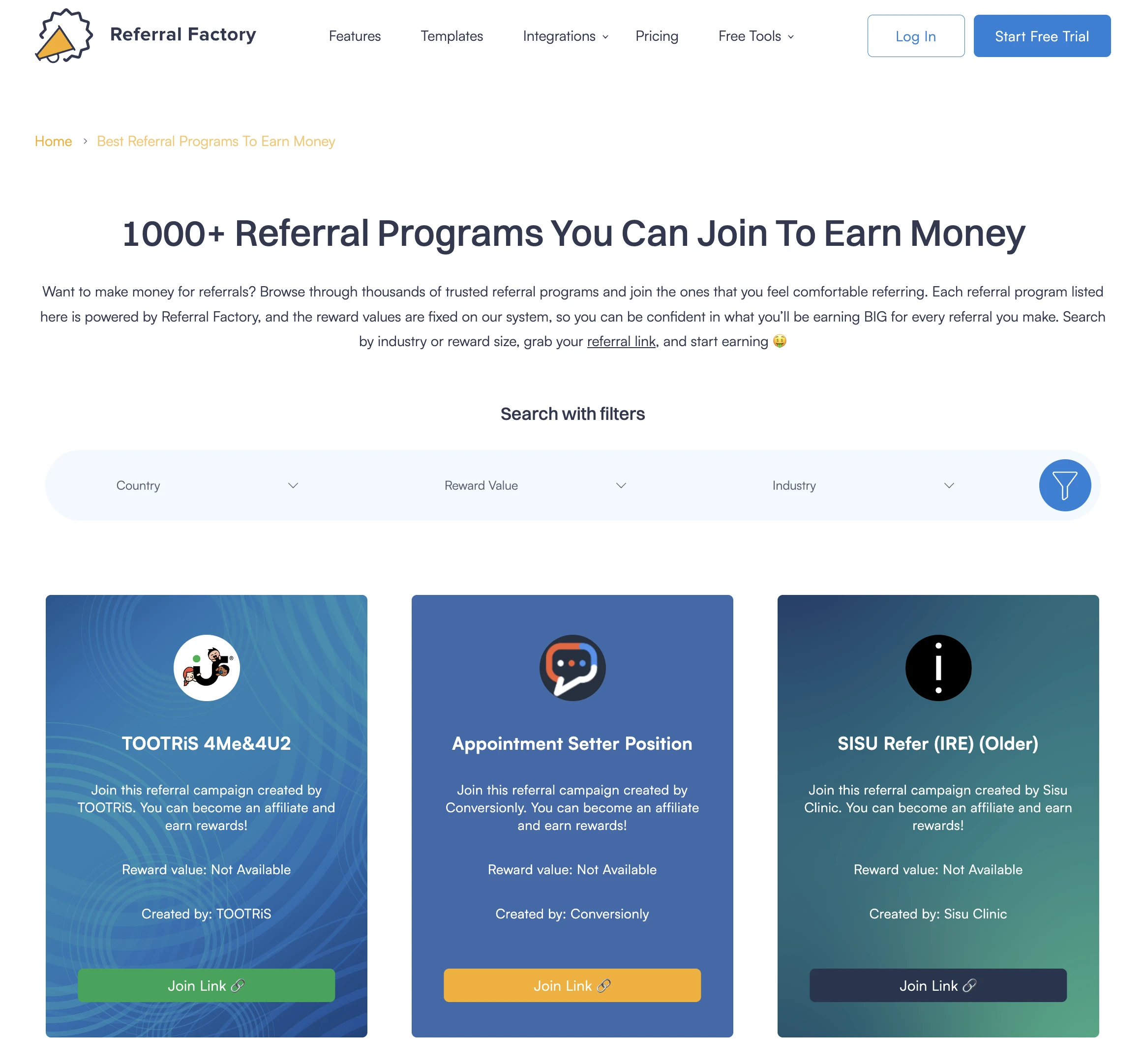
If you have more creative approaches in mind, use them! Experimenting is essential because recruitment can become much more appealing once it is out-of-the-box.
#4 They Are User-Friendly

Believe it or not, successful affiliates always care about an easy-to-use interface. In fact, having a straightforward design and rich functionality is a must for every good affiliate program. So, when it comes to your affiliate dashboard or the materials your affiliate program offers, they all have to be easy to understand and use. This is exactly why the affiliate or referral software you choose is so important!
A user-friendly interface ensures that affiliates can easily navigate through the dashboard, find the resources they need, and track their performance without any hassle. This simplicity allows them to focus on what they do best – promoting the product – rather than struggling with complicated systems.
Besides, affiliates need clear and concise reports to monitor their performance and earnings. A well-designed interface provides straightforward access to important metrics such as reach, conversions, and commission rates.
With Referral Factory, you can build a custom affiliate dashboard with all the relevant metrics.
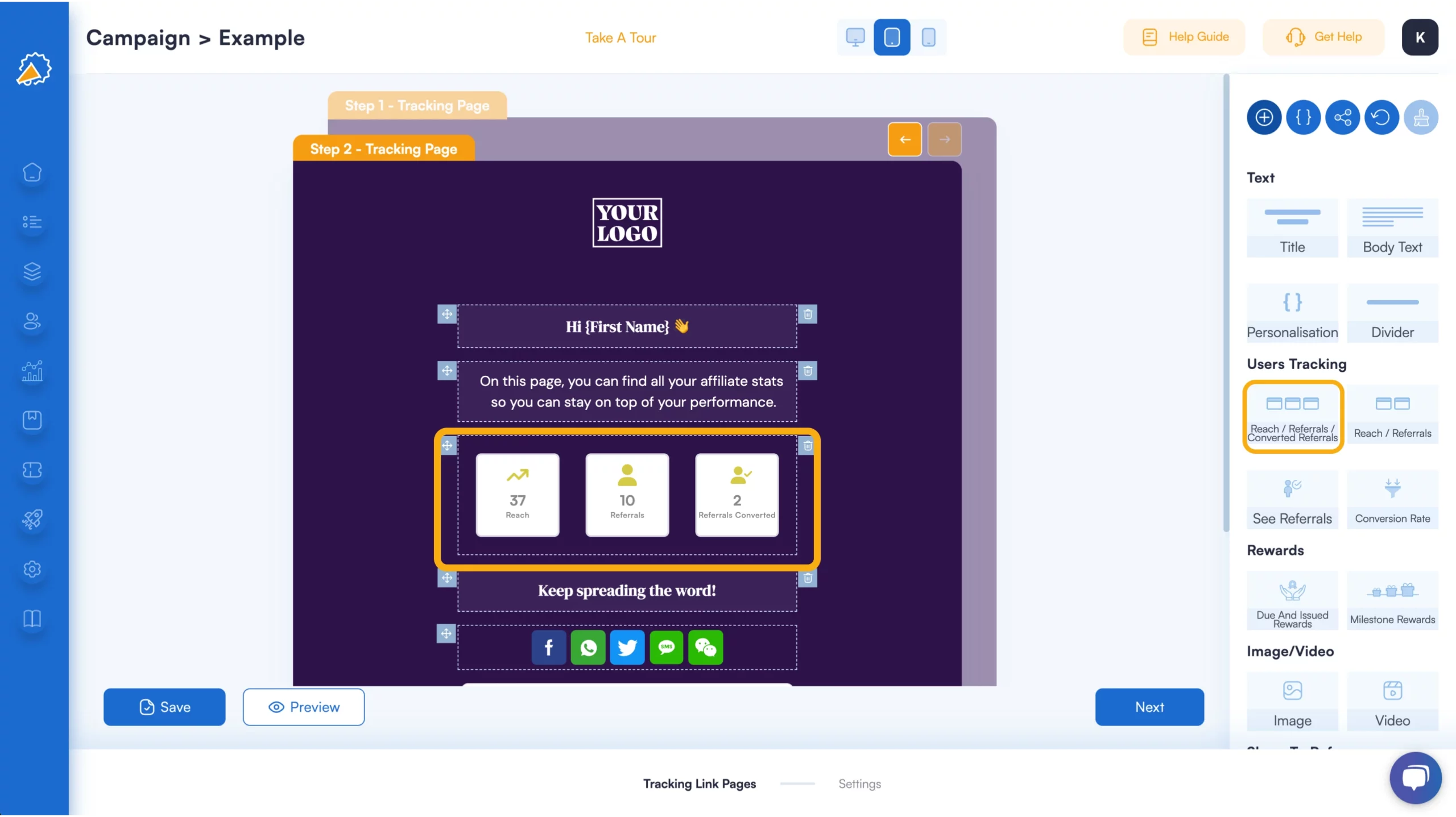
If you want to start a tiered affiliate marketing campaign, make sure the software you choose allows for your affiliates to track their milestones as well.

#5 Ongoing Support and Marketing Materials

An affiliate marketer without support is like a knight without armor. No jokes! Without a proper support system, new affiliate marketers will leave you at a much quicker pace than they joined.
If you have the budget for it, be sure to add a dedicated affiliate manager and provide 24/7 support. Why? Having an affiliate manager can make a world of difference. They can offer insights on optimizing each affiliate’s strategies, provide feedback on the performance, and even share exclusive tips to help them maximize their income (and your sales).
Also, consider adding an FAQ section on your website to provide comprehensive answers to the most common doubts.
What about marketing materials? The best programs equip their affiliates with a robust set of marketing resources and tools. It is a must.
This can include everything from high-quality banners and creatives to detailed marketing guides and templates. Providing these resources ensures that affiliates have everything they need to create compelling content and effective marketing campaigns. (This is something you can easily add to your affiliate dashboard).
Additionally, access to advanced tools like keyword research instruments, analytics platforms, and tracking software can significantly boost an affiliate’s ability to optimize their efforts and achieve better results.
All this is in your best interest, so here’s what you can offer:
- CTAs;
- Content guidelines;
- Creatives;
- Access to various tools to upgrade content.
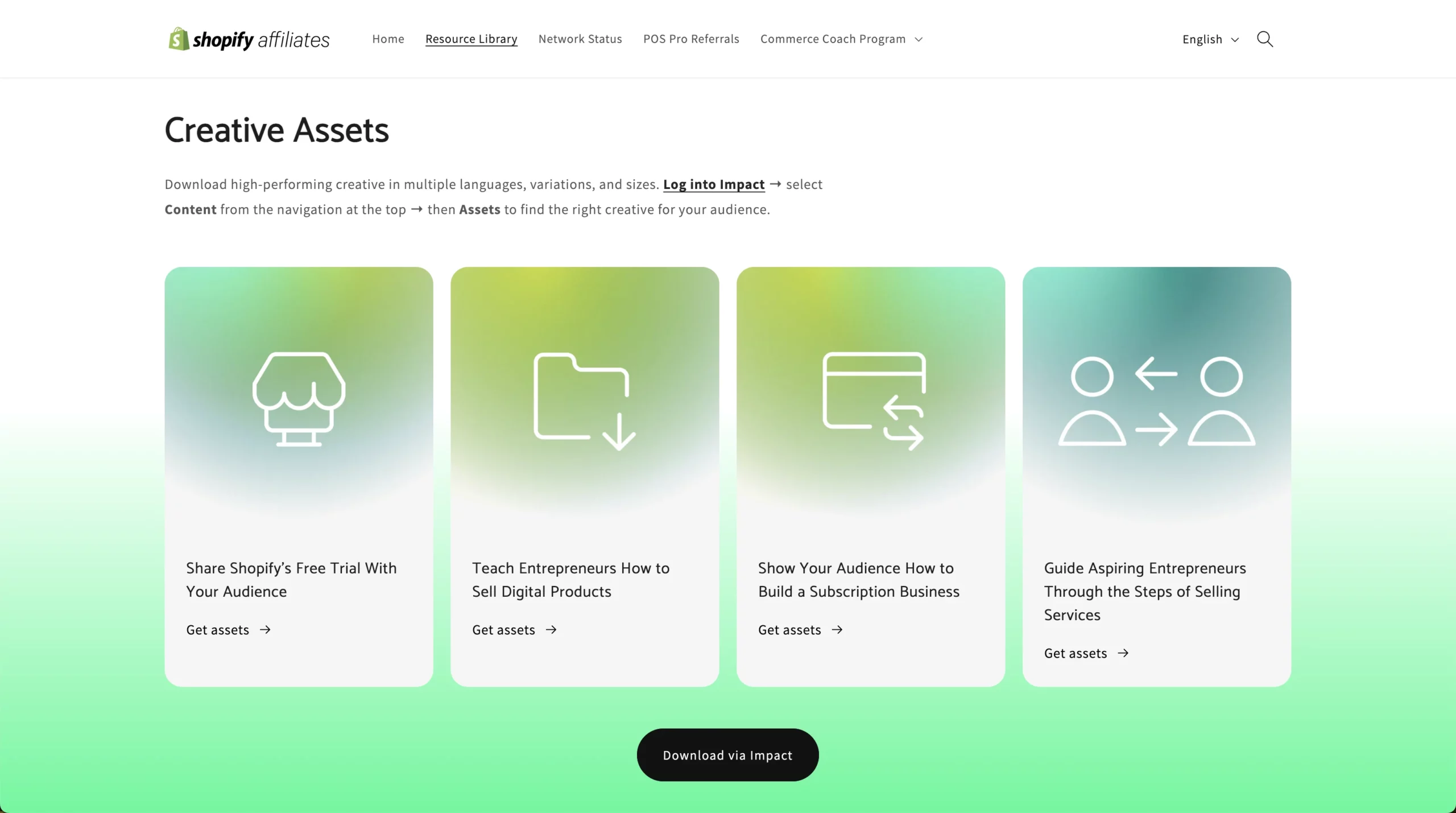
#6 Affiliate Cookie Duration / Cookie-Free Tracking

This is an important aspect many affiliate campaigns take into consideration but it can be a little technical, so let’s break it down. A cookie is a small tracking file stored on your users’ computers. It’s used to identify visitors to your site. You would have inevitably come across cookie warnings while browsing the web yourself… you know, the little notice you get when you first open a webpage and click “accept”.
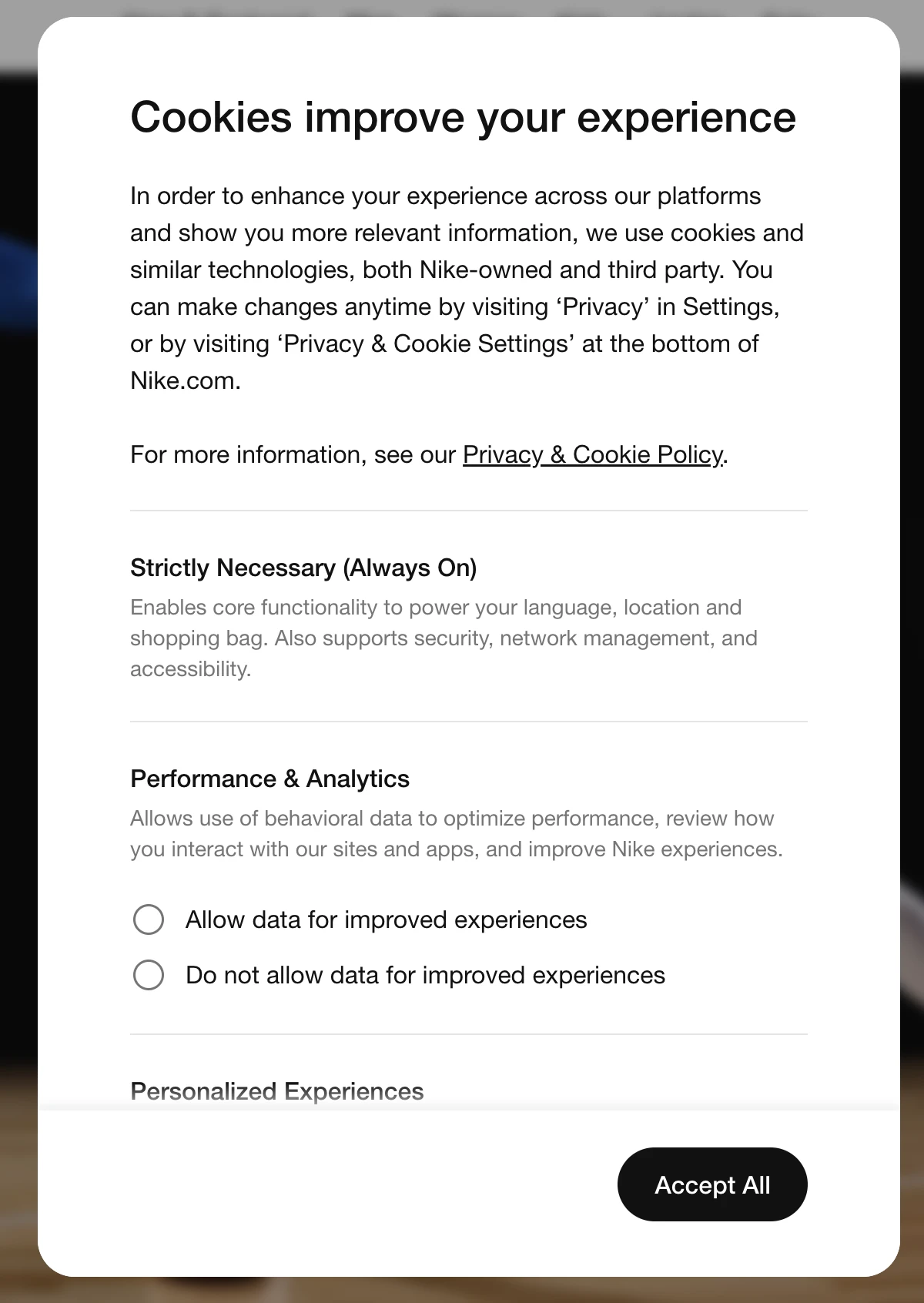
One common way to track affiliates is by using these cookies. When someone clicks on an affiliate link, they get “cookied” and that way, even if they come back later, the sale can be traced back to the relevant affiliate. (More on the potential pitfalls of this tracking method in a moment!)
It’s important to note that affiliate programs that use this tracking method often set a time limit on how long those cookies will last. And this changes the game for affiliates. Why is the expiration date such a game-changer? Well, the active period of these cookies (often referred to as the “cookie duration”) determines how long an affiliate can earn a commission after a visitor clicks on their affiliate link.
For instance, if a cookie duration is set to 90 days, an affiliate will receive credit for any purchase made by the referred visitor within that 90-day window. This can significantly impact the affiliate’s earnings, as longer cookie durations provide more opportunities for conversions.
Now… you may have already guessed this but there are some other big holes in this tracking method! What if someone clicks the link but doesn’t accept the cookies? What if they return to make a purchase but use their computer instead of their phone, where they originally clicked the affiliate link.
These issues, paired with increasingly stricter cookie regulations and privacy concerns, has led more and more companies to implement cookieless affiliate tracking solutions. Not to mention that cookie-based tracking precludes businesses with longer sales cycles from the game!
It’s worth noting that Referral Factory covers all your affiliate tracking without using cookies! That is a great plus for ensuring compliance and offering a seamless user experience. Plus, it means affiliates will be rewarded fairly, making your program more attractive to them too! Keep this in mind when choosing the software to track your affiliate marketing program.
#7 Transparency Is Non-Negotiable

If you want to build an affiliate system that really works, you need to provide complete transparency to your affiliates. Think of it as the foundation of trust in your partnership. Plus, without a proper dashboard and reporting, keeping your program up and running will be complicated.
So, what can you actually do? Offer your affiliates access to detailed performance reports! These reports should include metrics like clicks, conversions, issued rewards and rewards due. Good affiliate software will make it easy to set up custom affiliate dashboards!
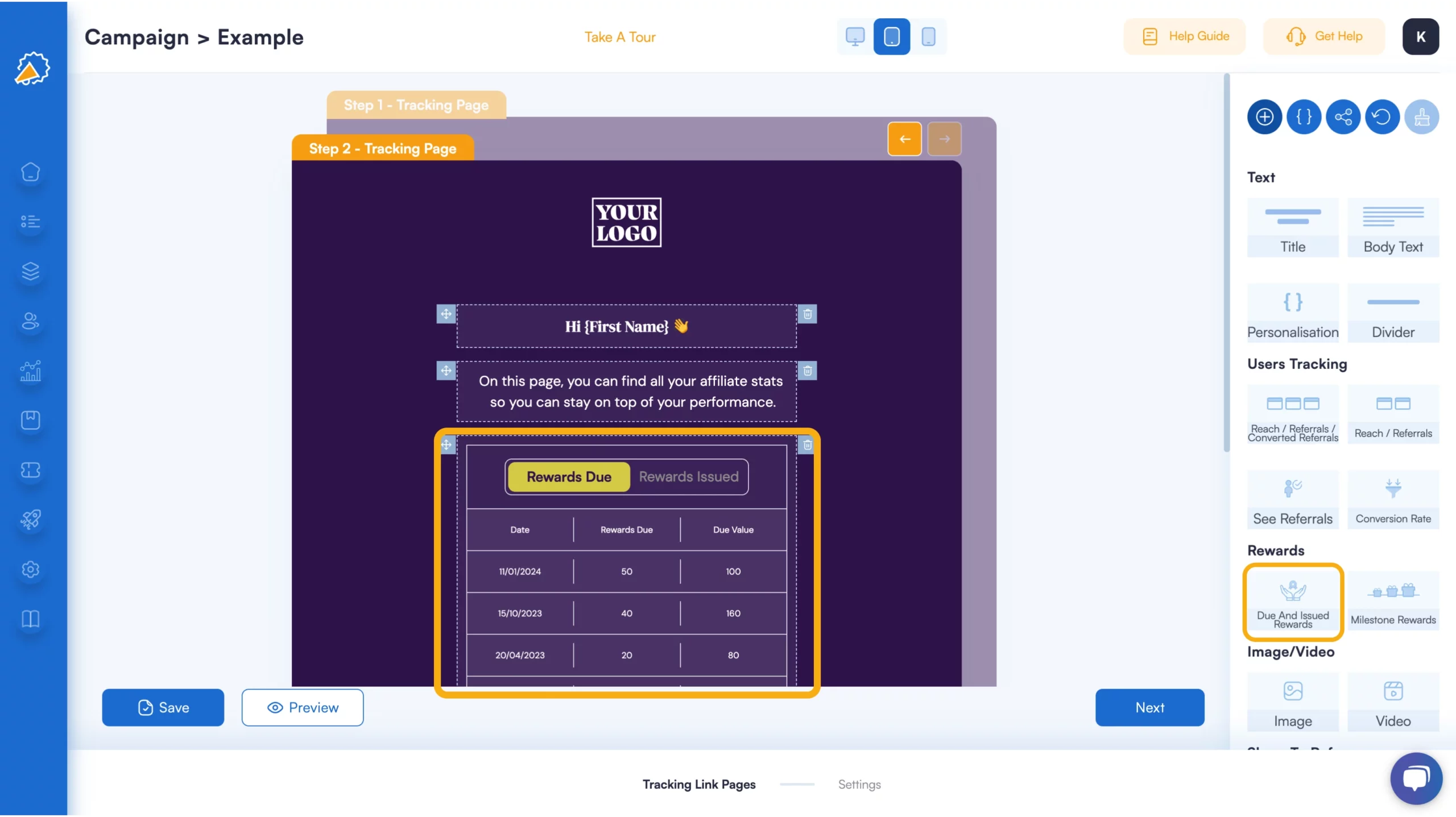
#8 Clear Communication

Clarity is crucial. Make sure your commission structure is straightforward and that you communicate it clearly to your affiliates. Provide detailed examples and FAQs to avoid any confusion.
An FAQ is a fantastic way to address common questions and concerns. Compile a list of frequently asked questions about your affiliate program and commission structure. Then, provide clear, concise answers. Questions might include:
- “How often are commissions paid out?”
- “Are there any minimum thresholds for payout?”
- “What happens if a sale is refunded?”
An FAQ is very convenient for you as well because both your current and potential affiliates can find out most of the things they want even without contacting you. Affiliate marketers can just read your answers and already have an idea about your program!
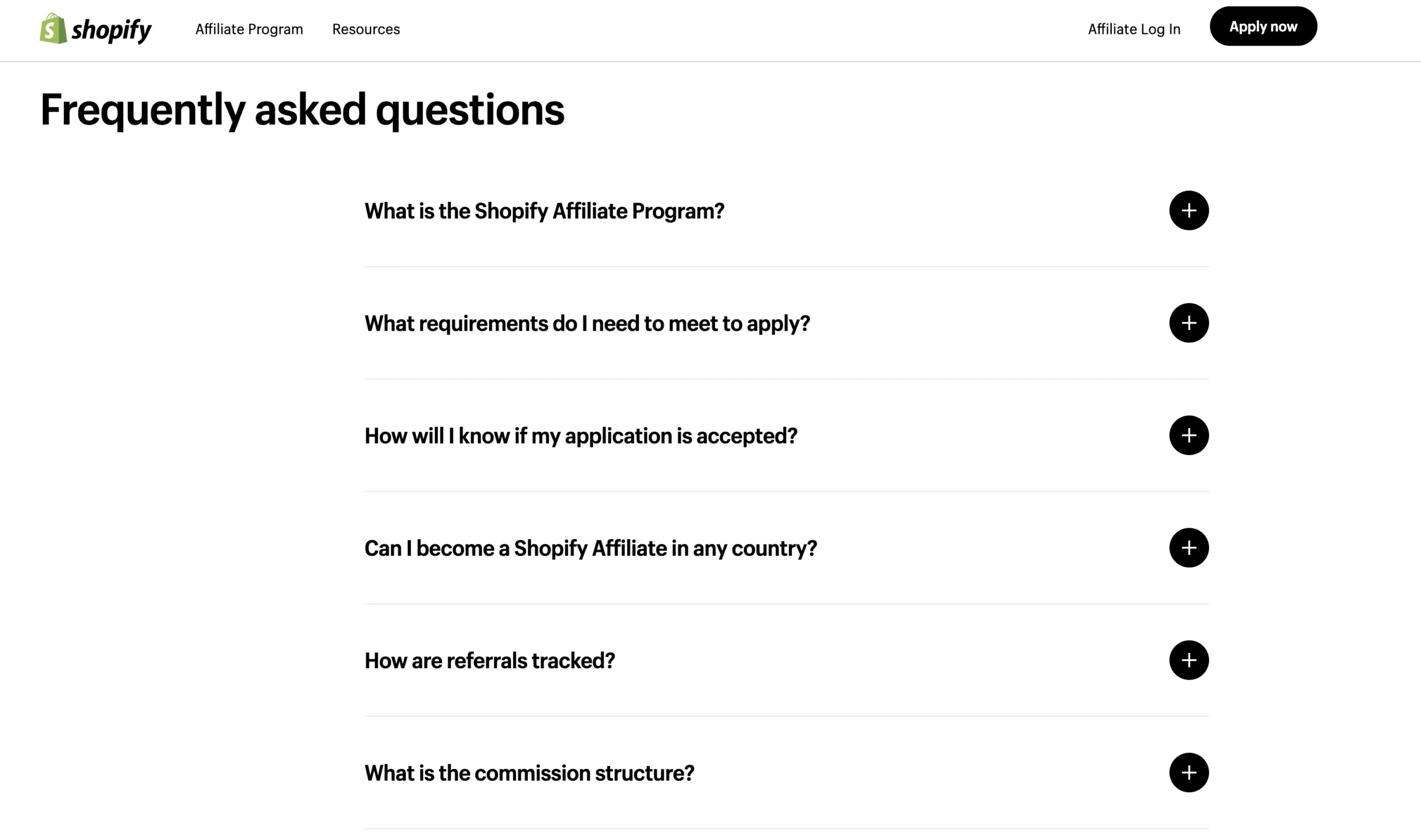
A transparent approach builds trust and can make your program more appealing.
What else?
Well, for example, your commission structure should be prominently displayed on your affiliate program’s landing page.
Provide detailed examples to illustrate how the commissions work. For instance, if an affiliate sells a product worth $100, explain that they would earn $10 with a 10% commission rate. Use easy language and avoid jargon – it might work well for some content types, but you have to be very careful with it when it comes to “frequently asked questions.”
Best Examples Of Affiliate Marketing Programs For Every Affiliate Marketer
Now that you’ve read the playbook, a definition for a great affiliate marketing program is easy to compile – it’s a program that not only pays well but also supports its affiliates with top-notch resources, provides reliable tracking, and offers products or services that people actually want to buy. In other words, it’s a win-win situation for everyone involved.
Now, let’s take a closer look at the actual examples you can copy from – for e-Commerce, SaaS (software as a service), and other business types.
E-Commerce Affiliate Marketing Programs
The explosion of e-commerce has created a goldmine for affiliates. With vast product selections, ease of promotion, and accessible tracking, online stores offer a wealth of opportunities to earn commissions.
These days, it is really hard to imagine an e-commerce business that doesn’t have affiliate programs. When you think about all those missed leads, it’s expensive not to have an affiliate marketing program! If you have an e-commerce business, these are the inspirational cases to look at:
Example #1: Amazon Associates

👀 Description: How could we not mention Amazon Associates? It’s the true OG of affiliate marketing as one of the oldest affiliate programs and an absolute favorite among most affiliate networks. As Amazon offers a vast product selection, every affiliate can easily find products relevant to their audience. As a result, new affiliate marketers join them literally all the time.
It’s worth noting that Amazon also launched a separate affiliate program for influencers and content creators as an extension of its Associates program (for brands and media companies).
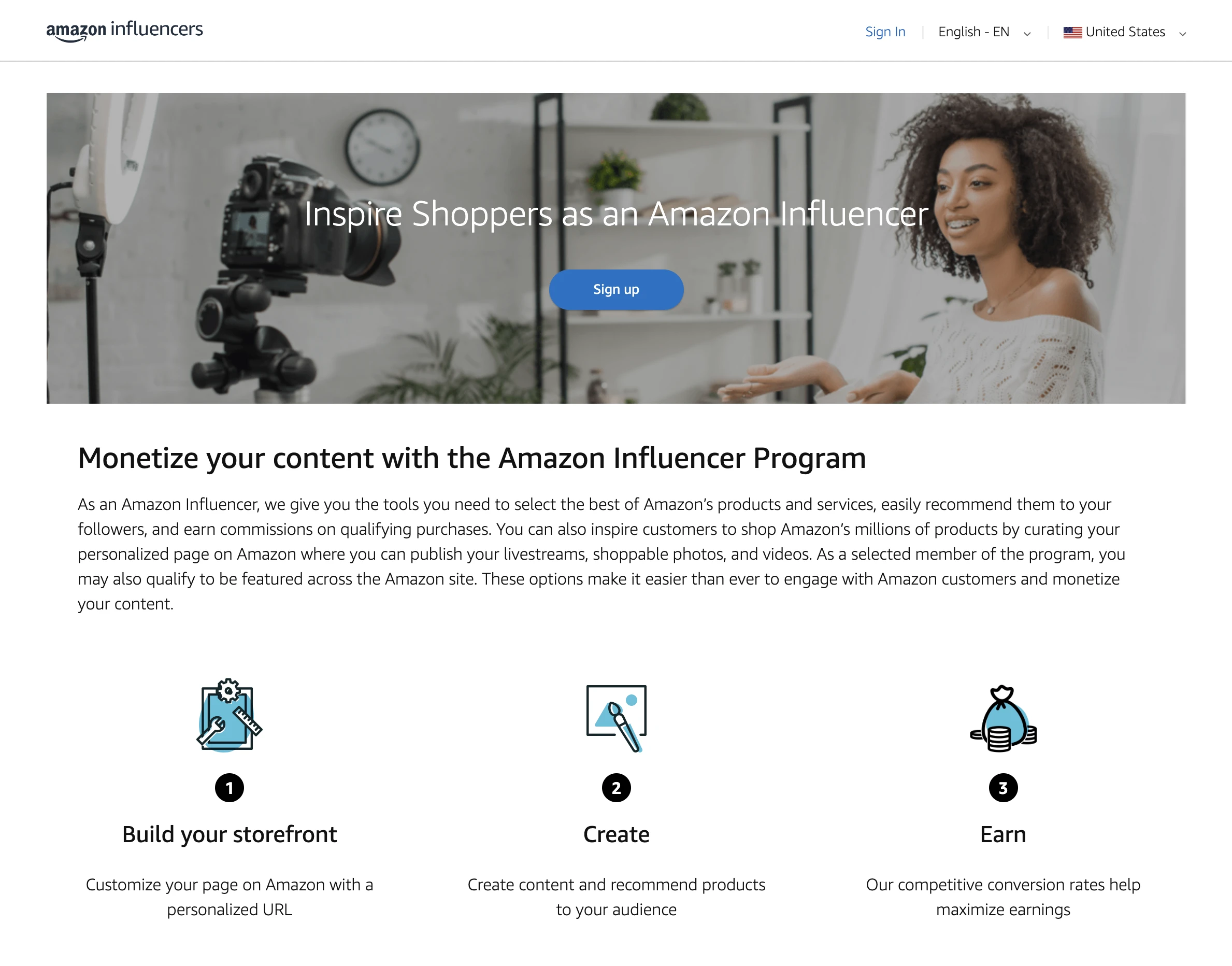
💁 Recruitment: Anyone can join Amazon Associates for free and there is a clear value proposition – the benefits of joining their program are understandable.
Amazon uses many ways to inform people about its program: there is search engine optimization, Google Ads, and landing pages on its website. Even though it’s very famous, Amazon still promotes their program like a pro to find more successful affiliate marketers.
✍️ Tracking: Amazon uses cookies that track purchases for up to 90 days after clicking your affiliate link.
💵 Payouts: Commission rates vary by product category but can be as high as 20%. Payments are typically made monthly via direct deposit or gift card.
💡Why does it work so well? The biggest advantage of an Amazon affiliate program is that they don’t need an introduction: everybody knows and uses this platform. This is an obvious reason.
Yet, it wouldn’t be so smooth if everything else wasn’t as good. While it’s not among the highest-paying affiliate programs, it still allows affiliates to earn well and businesses to see the results of their affiliate sales.
One of the most appealing things to creators is the ease of becoming an affiliate. Amazon’s affiliate program is a good example in terms of simplicity and basic requirements for creators who want to participate.
Of course, emulating the Amazon Associates program is not easy. But we can still take the best of their thinking and apply it to smaller affiliate marketing campaigns. What is worth trying?
- User-friendly interface: If you don’t want to confuse and scare away your potential affiliates, make sure your affiliate portal is easy to navigate and use. Also, simplify the process of creating and managing affiliate links.
- Keep reasonable requirements: Make your entry requirements as straightforward as possible – it will help you attract a diverse range of affiliates.
- Offer transparency: Provide affiliates with clear and detailed reports on their performance and earnings.
- Make sure your payouts are regular and reliable: Ensure timely and consistent payouts to maintain trust and motivation among affiliates. For this, you can automate payments using affiliate marketing (or referral program) software.
- Widen your product range: While you may not have Amazon’s extensive catalog, offering a variety of products can attract more affiliates.
- Share your commission rates openly: The more detailed you are when describing your affiliate program, the higher the chances you will attract active affiliates.
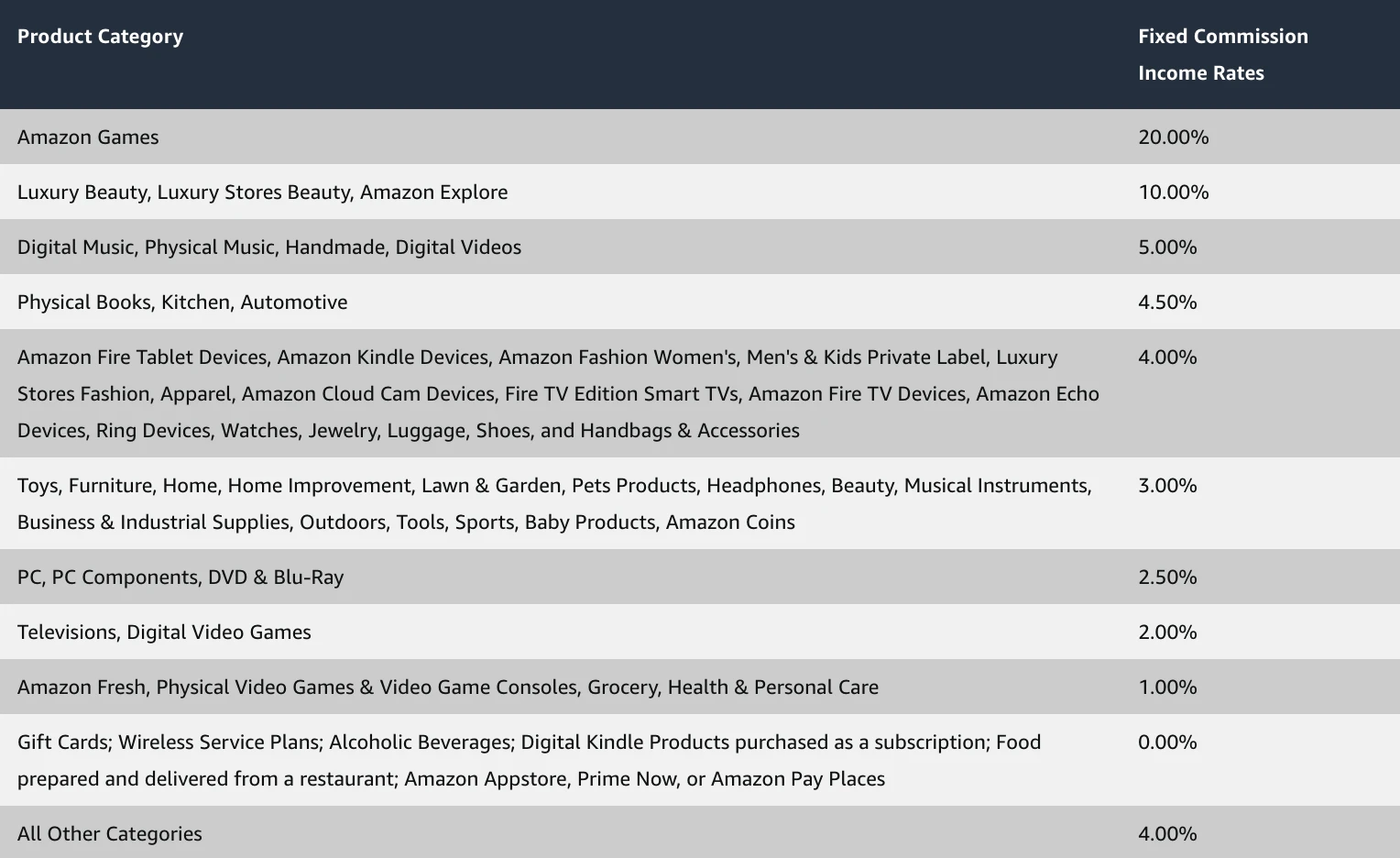
Example #2: Sephora
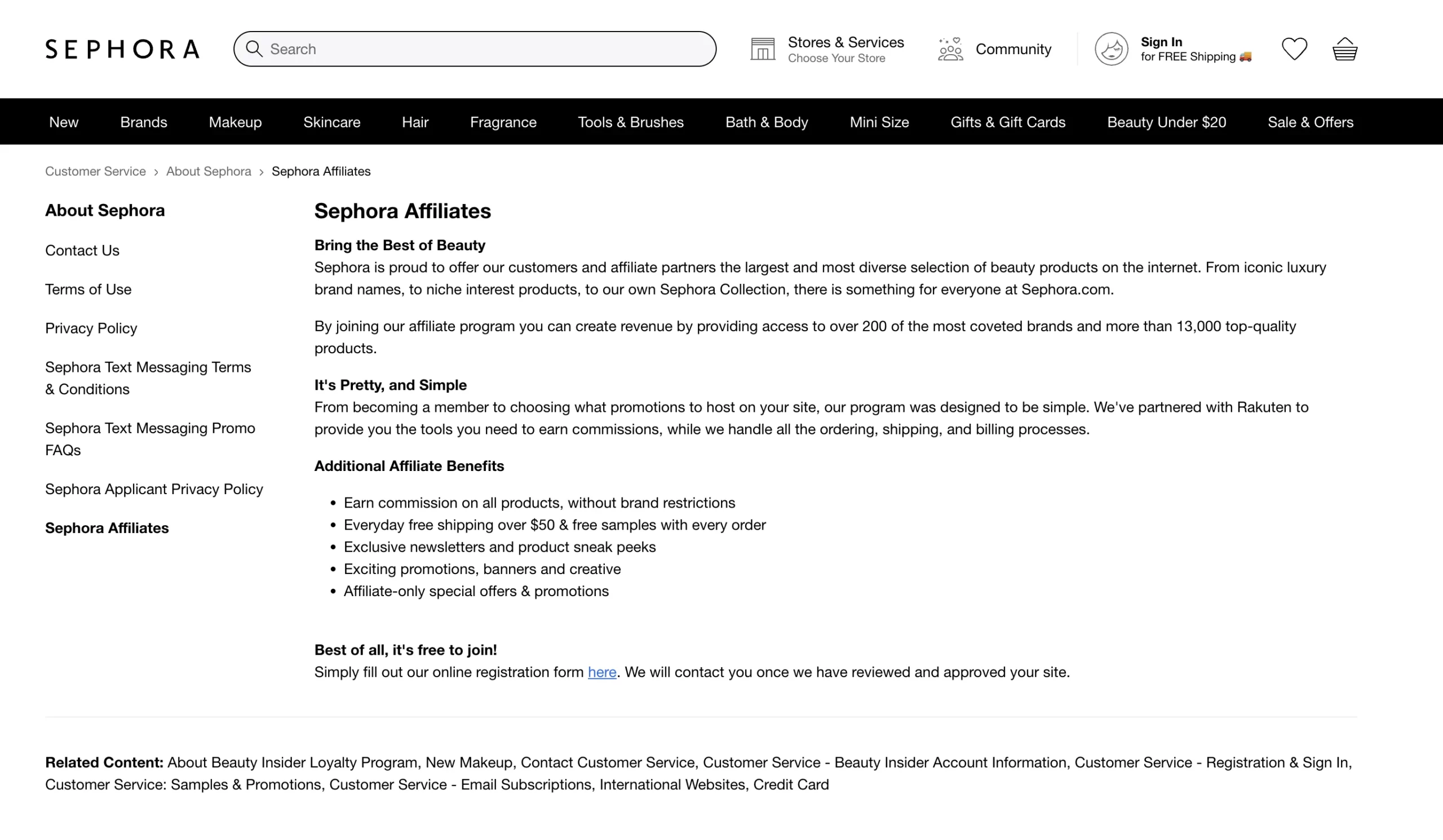
👀 Description: Sephora’s affiliate program allows content creators and influencers to promote their beauty products and earn commission on each sale driven through their unique link. According to their site, there are “over 200 of the most coveted brands and more than 13,000 top-quality products.”
💁 Recruitment: Sephora partners with Rakuten Advertising to manage their affiliate program. Signing up is free and open to anyone with a website, social media presence, or YouTube channel that aligns with the beauty and fashion niche.
Sephora offers a very easy registration form to join, and, as they say, “It’s pretty and simple,” meaning that everyone can be a part of their affiliate program.
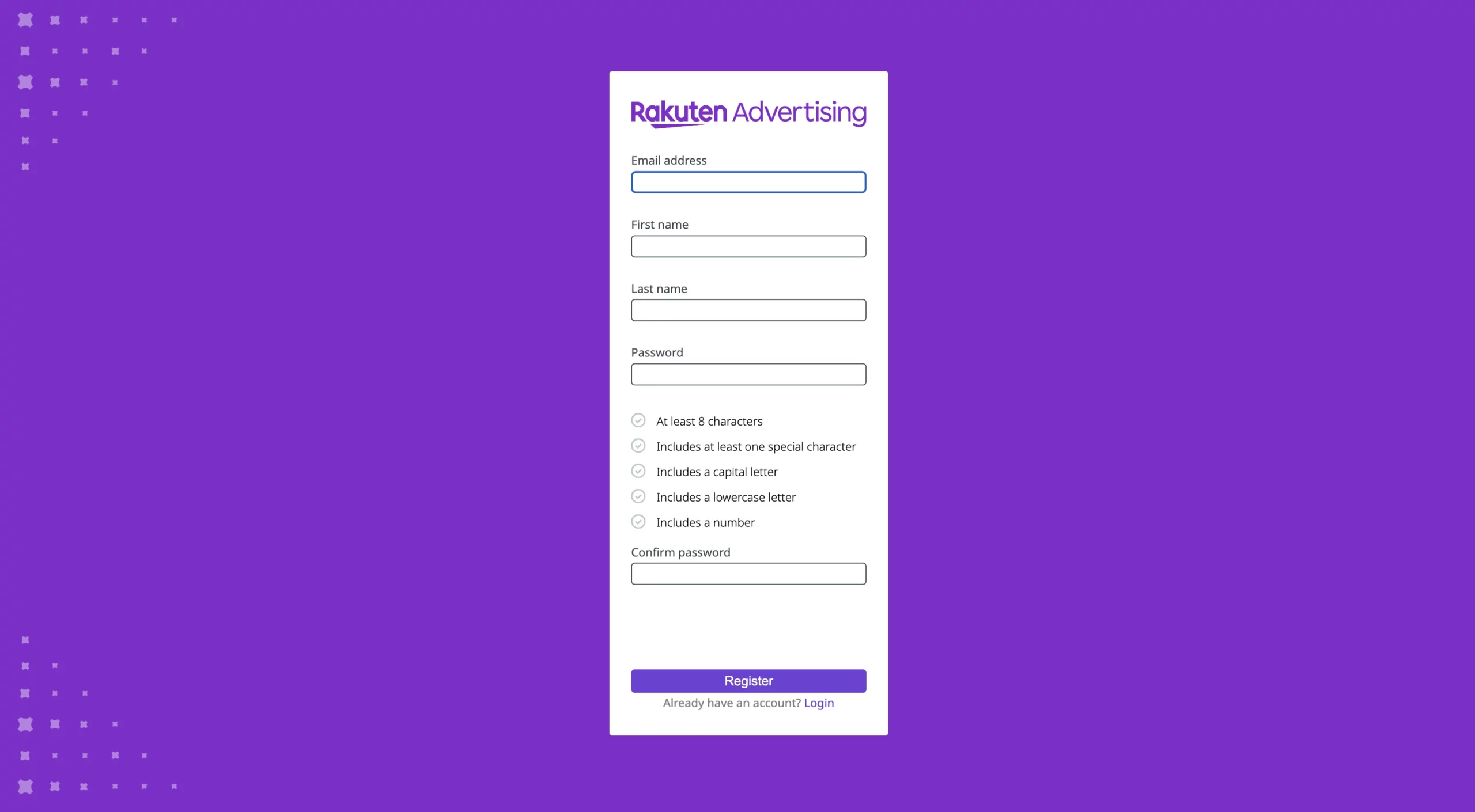
✍️ Tracking: Rakuten provides affiliates with unique tracking links and banners to embed on their platforms. These links contain cookies that track referred customers for a set period (usually 30 days) after clicking the link. Any purchases made within that window by the referred customer will be credited to the affiliate.
💵 Payouts: The most appealing thing is that Sephora offers a fixed commission structure, with a minimum payout of $50. Affiliates typically earn a commission of 1.8% for existing Sephora customers and up to 6% for new customers they refer.
Payments are issued monthly once the commission reaches a minimum threshold (which may vary depending on the affiliate partner).
💡 Why does it work so well? First of all, it’s very easy. All affiliates have to do is share their links to products and they’ll earn a commission once someone clicks and makes a purchase. But what else?
✔️ Additional benefits: As an affiliate, you become entitled to the following benefits: free shipping over $50, free samples with every order, exclusive newsletters, product sneak peeks, and affiliate-only special offers and promotions.
✔️ High earning potential: The tiered commission structure incentivizes affiliates to bring in new customers, resulting in a higher payout.
✔️ Brand recognition: Sephora is a trusted and popular beauty brand, so it is a part of the appeal, like in the case of the Amazon Associates program.
✔️ Wide product range: With a vast selection of makeup, skincare, fragrance, and hair care products, affiliates can cater to diverse audiences.
Want to copy Sephora’s game plan? Here’s an affiliate program template to quickly and easily set up your own affiliate program.
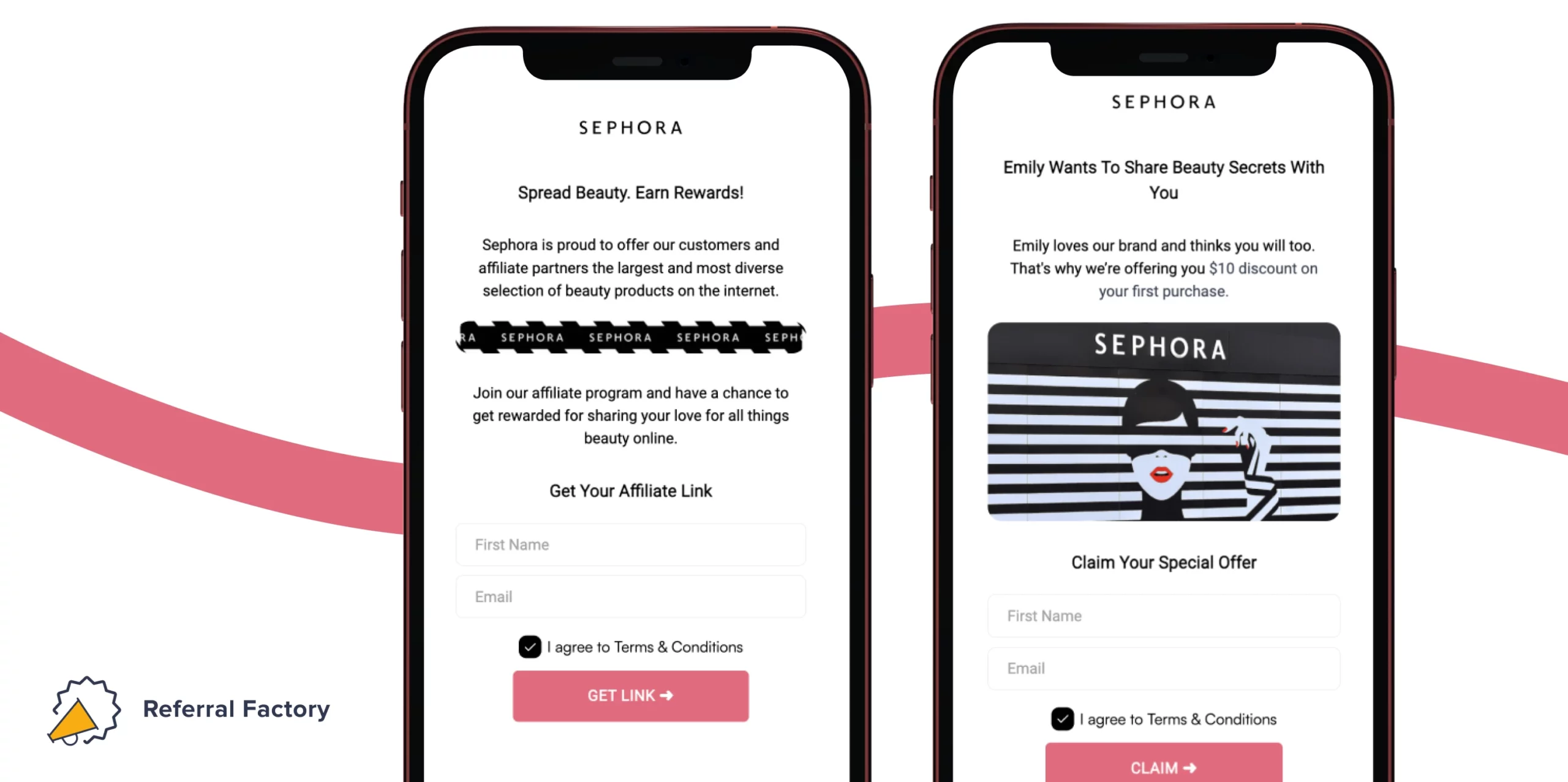
Example #3 Shopify
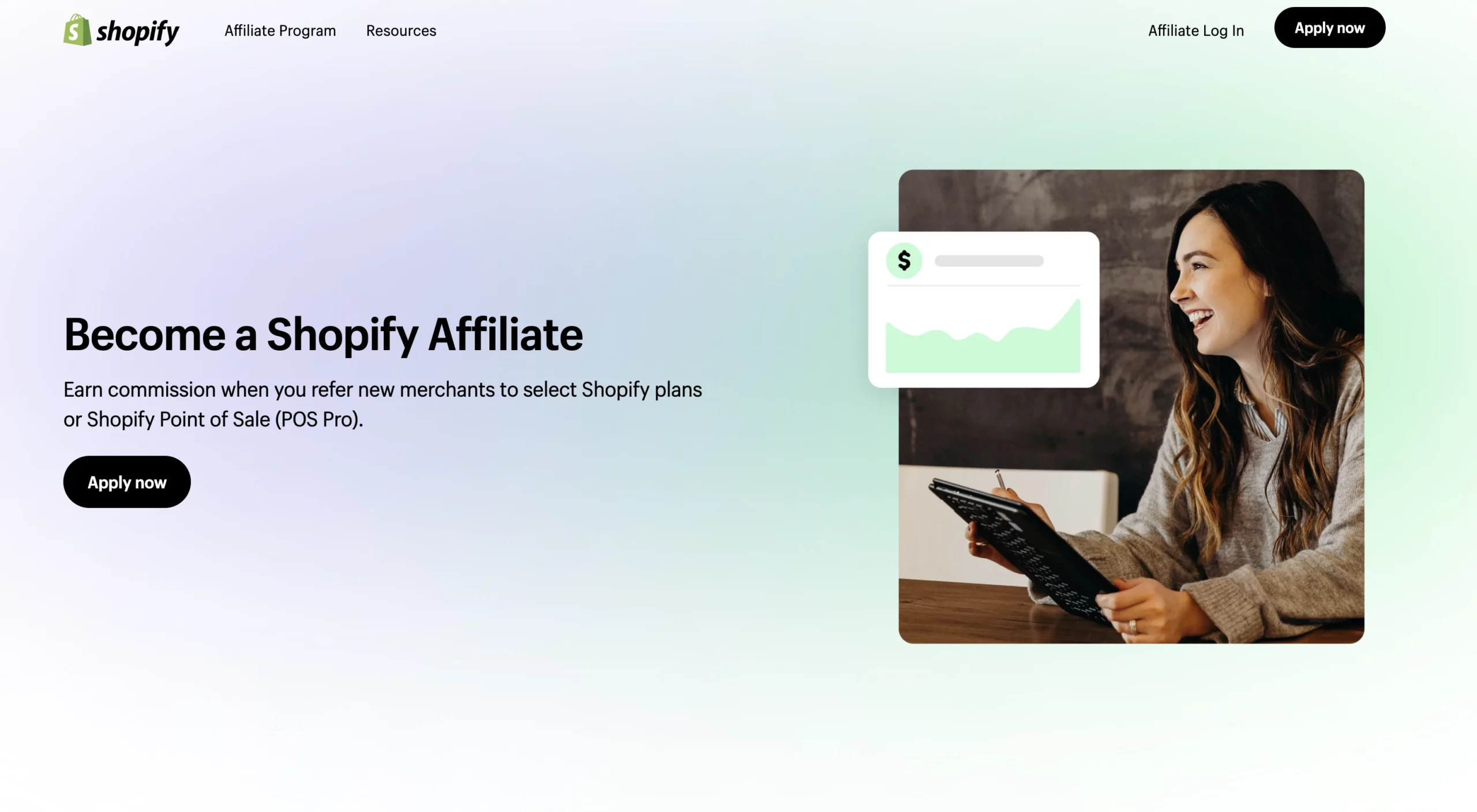
👀 Description: The Shopify Affiliate Program brings together thousands of content creators, educators, influencers, and review sites from around the world and ultimately helps their audiences launch successful businesses.
💁 Recruitment: Besides commission rates, Shopify affiliates gain access to a global creative library, creatives, newsletter, and curated email programming that supports their content creation. Sounds like a full pack!
✍️ Tracking: Shopify uses cookies to track referrals for 30 days after a link is clicked.
💵 Payouts: Commissions are based on a recurring monthly payment structure tied to the subscription fees paid by referred merchants. However, affiliates can choose to receive payments on a bi-weekly basis. Also, depending on location, affiliate commissions can be up to $150 for all full-priced plan referrals.
Here’s the table that shows which plan referrals are eligible for commission earnings:
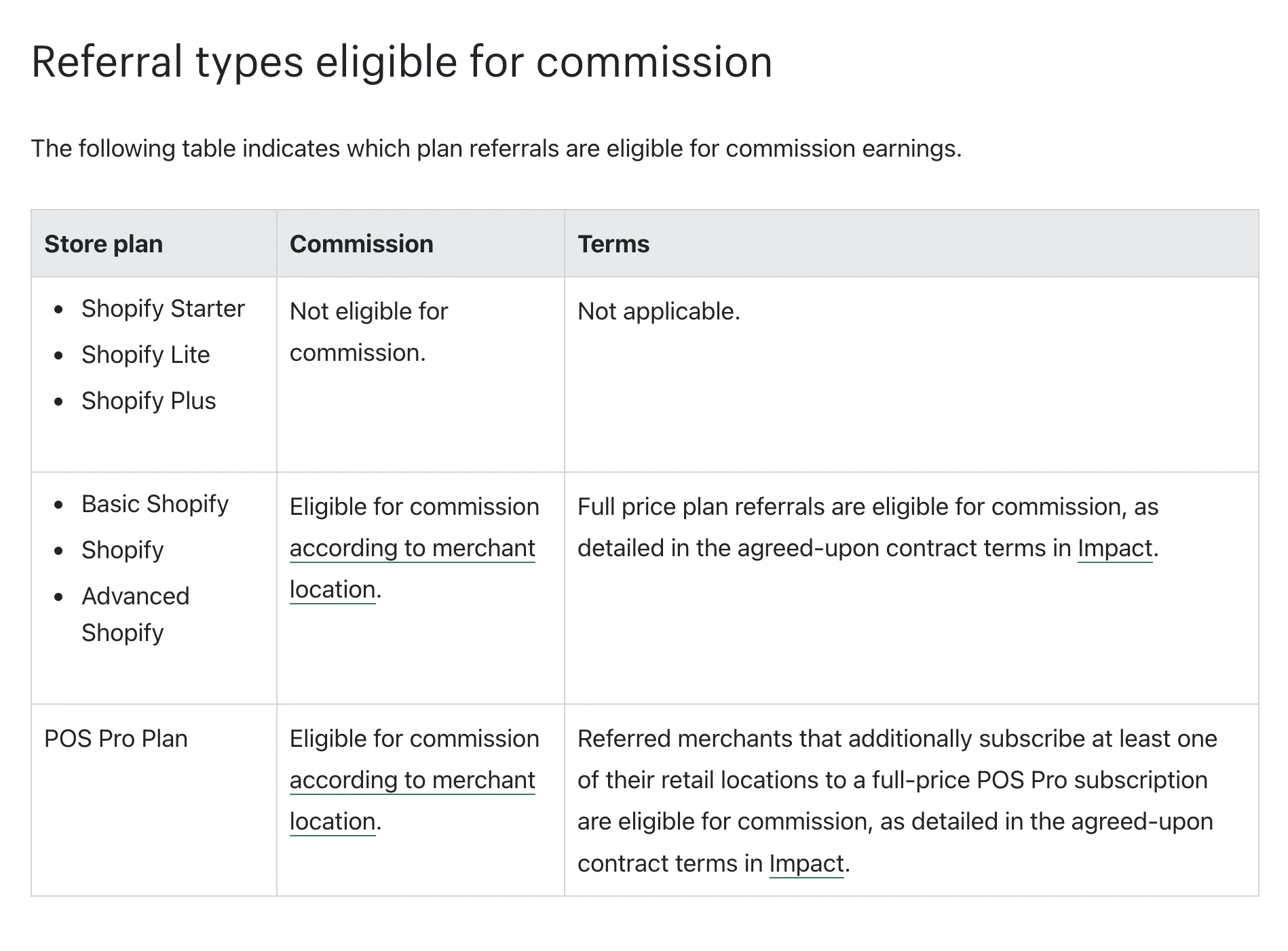
💡Why does it work so well? While there is obviously strong brand recognition, Shopify offers more powerful advantages:
✔️ Strong target audience: Shopify caters directly to a large and growing market of entrepreneurs who want to launch an online business. This warm audience is more likely to convert through affiliate links.
✔️ Recurring revenue model: Unlike programs with one-time payouts, Shopify offers recurring commissions based on monthly subscription fees. This incentivizes affiliates to focus on building successful online stores for their referrals. It is a win-win situation.
✔️ Content marketing synergy: The program aligns well with content creators who already focus on e-commerce or entrepreneurship.
SaaS Affiliate Marketing Programs
Another big slice of the affiliate market is the SaaS (software) industry. Building and running a SaaS affiliate marketing program in this industry is a must! Why? SaaS businesses thrive on subscription-based models, where customer retention and recurring revenue are key.
An affiliate program aligns perfectly with this model, incentivizing affiliates to bring in new subscribers who will generate ongoing revenue. Affiliates benefit from recurring commissions, and SaaS businesses benefit from sustained growth.
As for any other business, an affiliate marketing program is highly scalable for SaaS. As the SaaS business grows, so can its affiliate network.
Here are some good examples you can take into consideration when creating your own SaaS affiliate program.
Example #4: Semrush
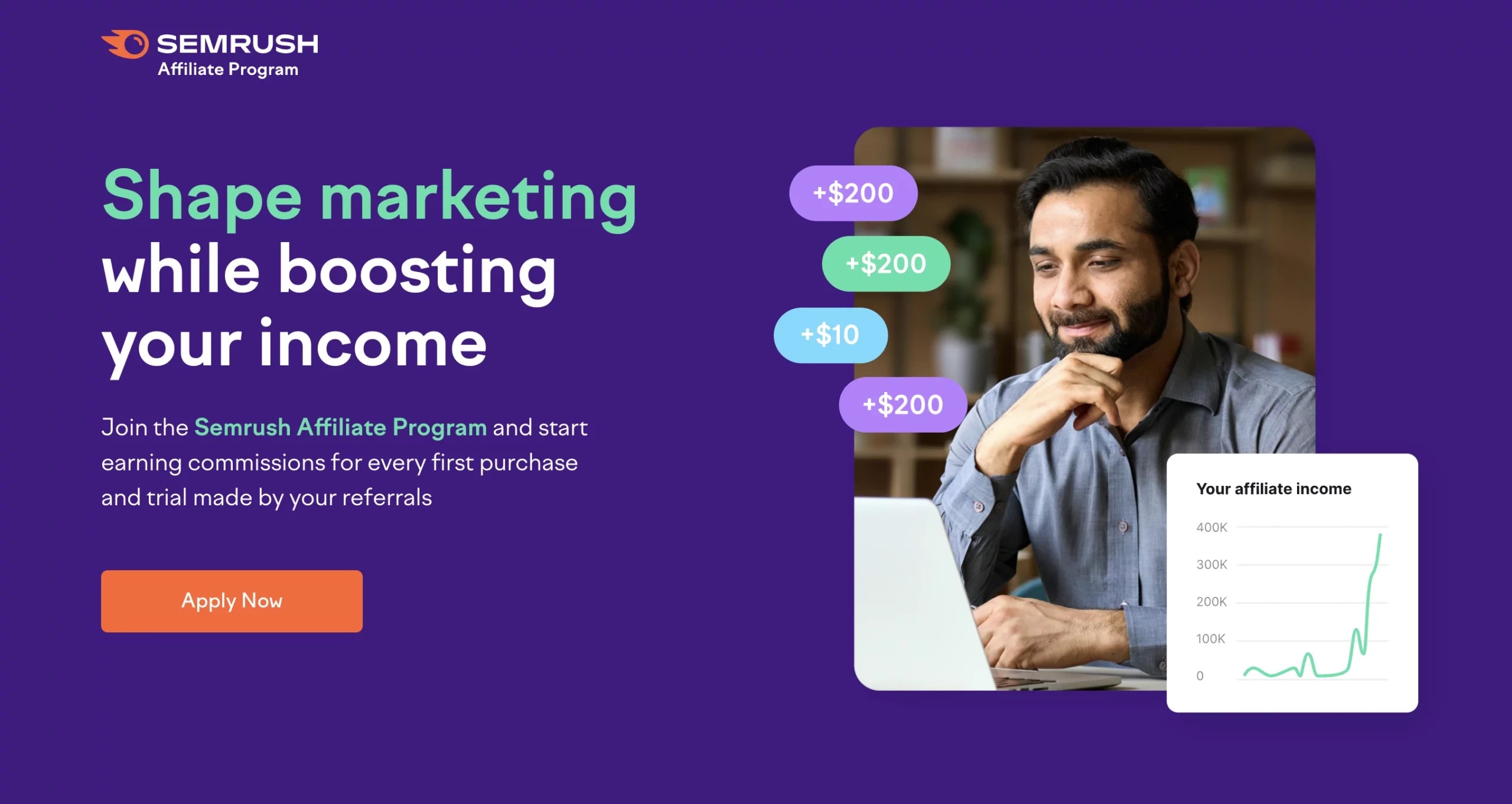
👀 Description: You might know Semrush as a keyword research tool and a leading SEO platform. Why is it an interesting case in terms of affiliate marketing? Semrush offers a free affiliate program targeted at publishers, paid search specialists, and, of course, creators. Many might see it as a narrow audience, but we say it’s rather well-defined.
💁 Recruitment: Anyone who creates content related to SEO, PPC advertising, public relations, content marketing, or general marketing can apply to join the program. But there’s more to it.
Here is how they frame the advantages for their affiliates:
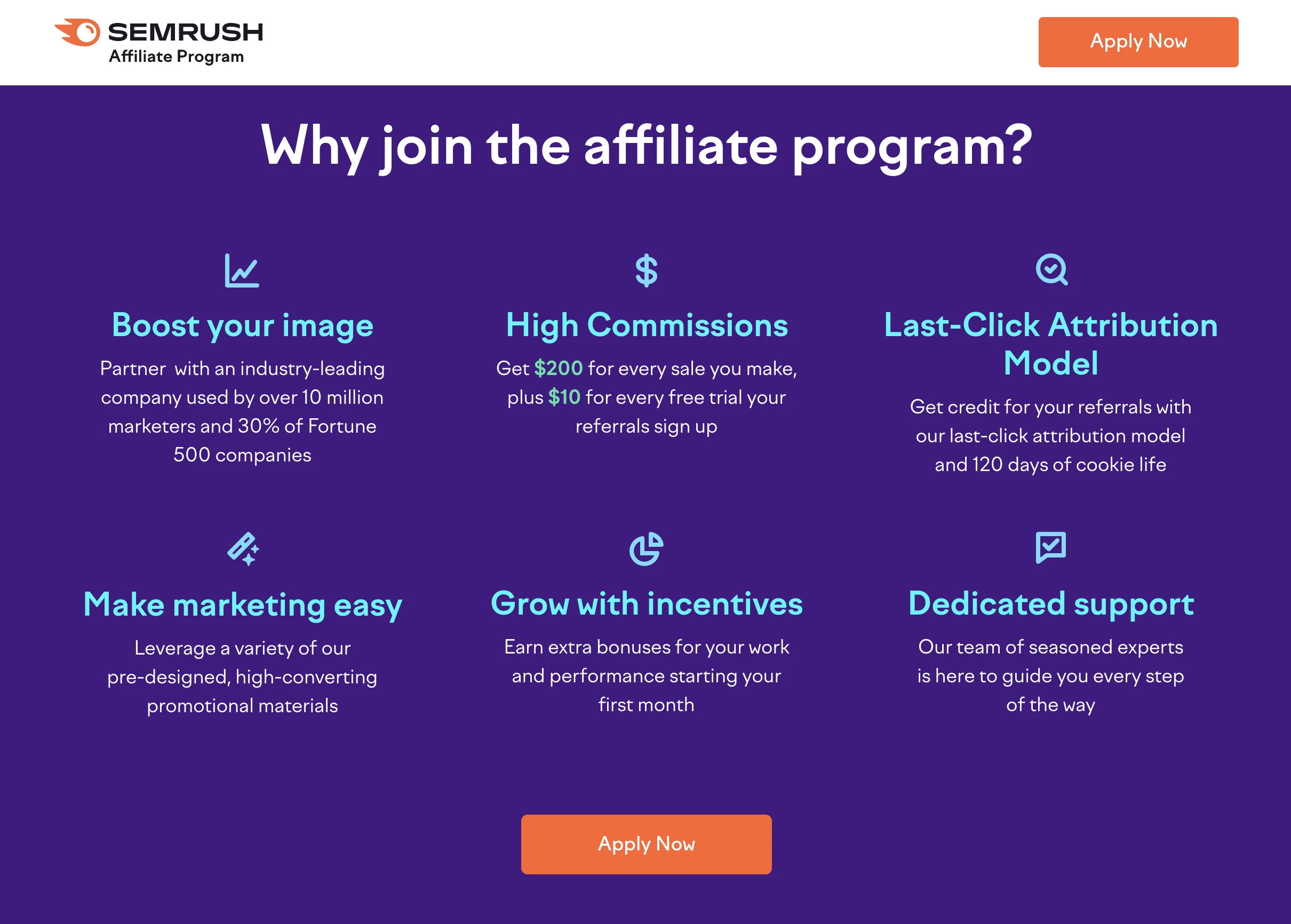
✍️ Tracking: Semrush uses cookies to track referrals for 120 days after a link is clicked. This generous window gives affiliates credit even if potential customers take time to explore Semrush before subscribing.
💵 Payout: The program offers a tiered commission structure. Affiliates can earn:
→ $200: For each new paid subscription generated through their affiliate link.
→ $10: For each new free trial signup.
Semrush also offers a tiered way of earning and a quarterly bonus system:
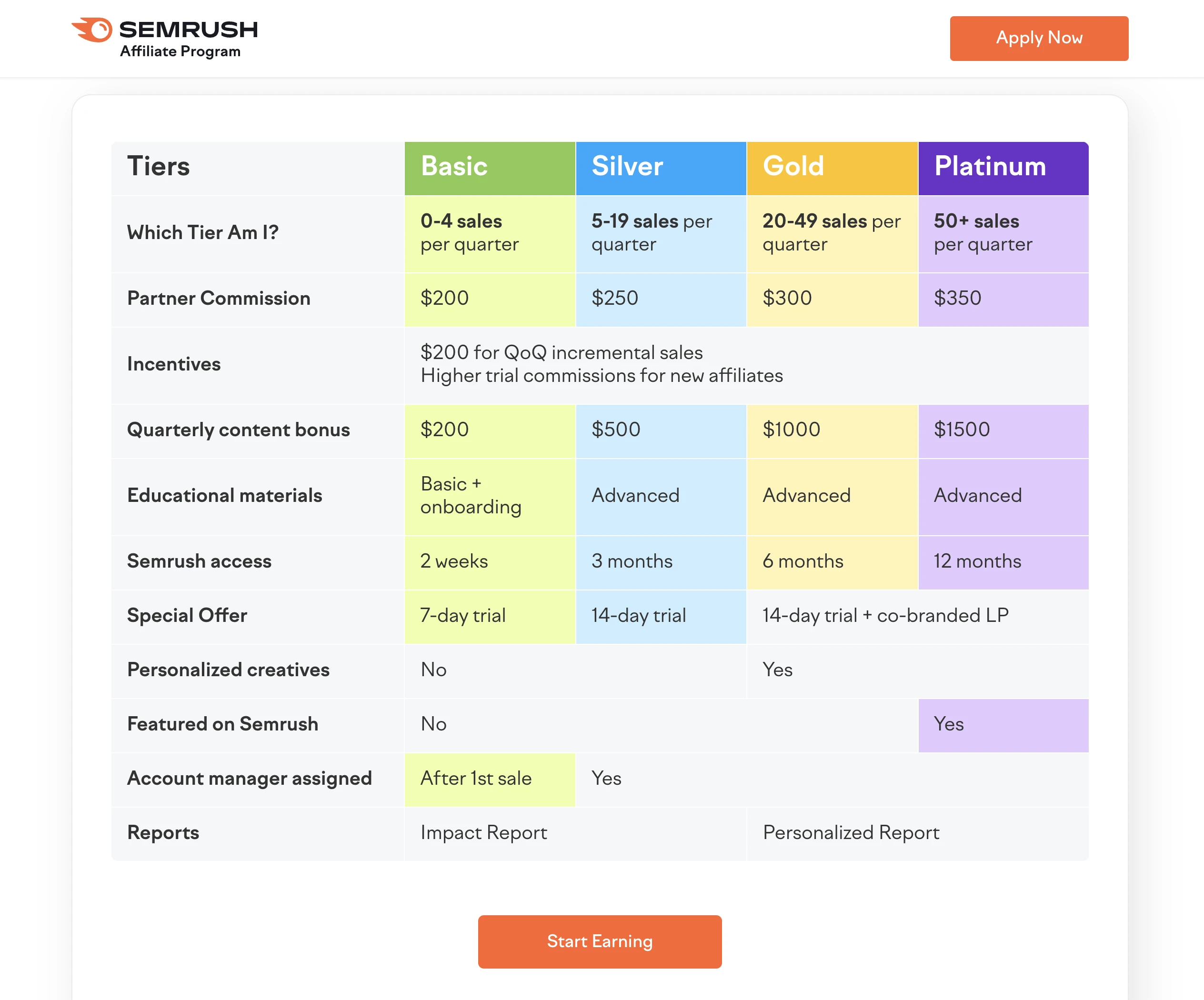
It’s also important to know that Semrush’s affiliate program is hosted on the Impact Network, so affiliates can withdraw their commission according to its payment processing.
💡 Why does it work so well? The first and foremost reason is at least $200 commission for paid subscriptions – one of the highest offered in the affiliate marketing industry. Of course, that is what makes the program financially attractive for affiliates.
They also have a 120-day cookie tracking window, which allows affiliates to earn credit even from delayed conversions.
There is also an important point for those who think that their niche is too specific. If you take a look at Semrush, they also target a niche market. But they’ve turned that into their advantage by narrowing down their audience to mostly marketing professionals.
You can’t deny that Semrush itself is very good at creating reliable materials. They craft valuable and engaging content as a part of their marketing strategy! So their reputation precedes them anyway.
Their niche targeting allows affiliates to concentrate their efforts on a particular market segment that is already interested in and benefits from the product. This hyperfocus leads to higher conversion rates compared to more generalized affiliate programs.
Example #5: Freshbooks

👀 Description: The FreshBooks Affiliate Program allows content creators and online influencers to earn commissions by recommending FreshBooks, a popular accounting SaaS designed for freelancers and small businesses.
💁 Recruitment: Anyone who creates content targeting freelancers, entrepreneurs, or small businesses can apply to join the program. Here is their recruitment message:
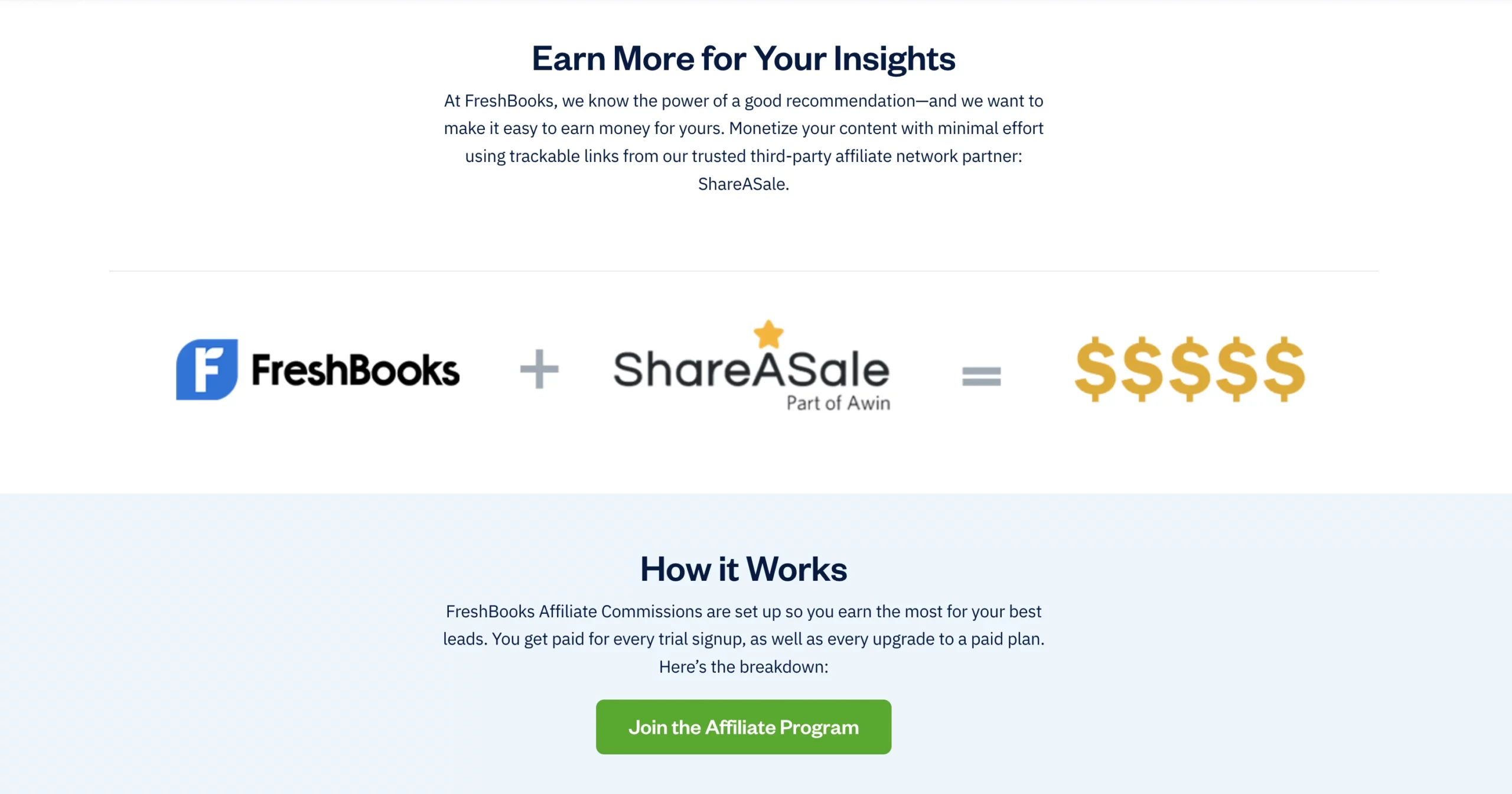
✍️ Tracking: FreshBooks uses cookies to track referrals for a generous 120 days after a link is clicked.
💵 Payouts: FreshBooks offers a two-tiered commission structure:
→ $5: For each free trial signup.
→ Up to $200: For each new paid subscription, the exact amount varies based on the chosen plan.
💡 Why does it work so well? The first reason is simple: they managed to find a good market fit. FreshBooks targets a specific audience – freelancers and small businesses – who actively seek solutions for managing finances and simplifying accounting.
This focused approach allows affiliates to connect with an already interested audience. Among other reasons:
✔️ Tiered commission structure: The program offers commissions for both free trials and paid subscriptions. This caters to affiliates at different stages of their audience development. Affiliates with newer audiences can still earn from trial signups, while established creators can aim for higher commissions from paid plans.
✔️ Proper support: This is one of the important factors that may seem less vital at first. FreshBooks provides dedicated affiliate support and access to promotional materials. This empowers creators to effectively market the software and maximize their earning potential.
✔️ Low entry barrier: Anyone creating content relevant to freelancers and small businesses can join. This is what makes the program accessible to a broad range of creators.
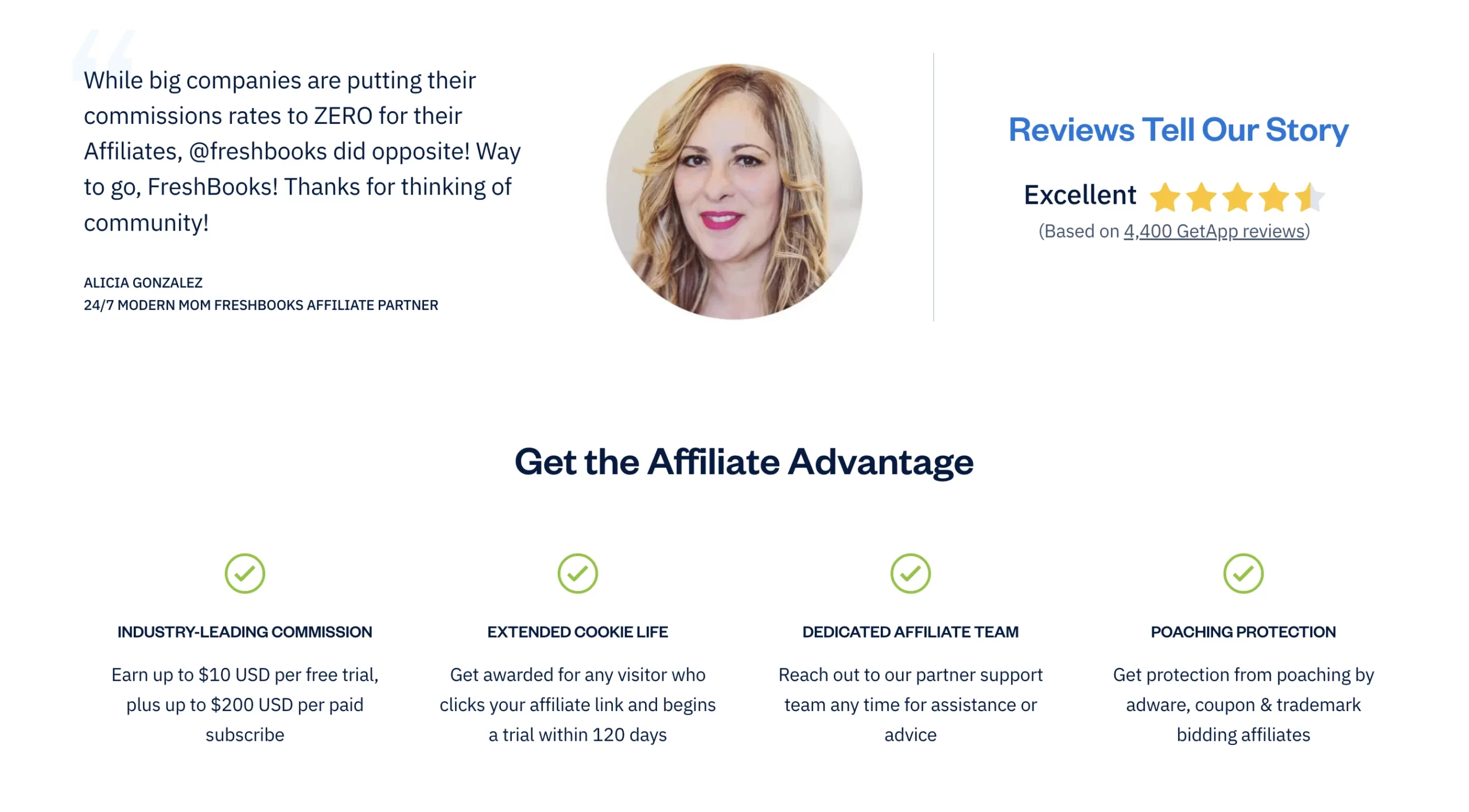
Example #6: ActiveCampaign
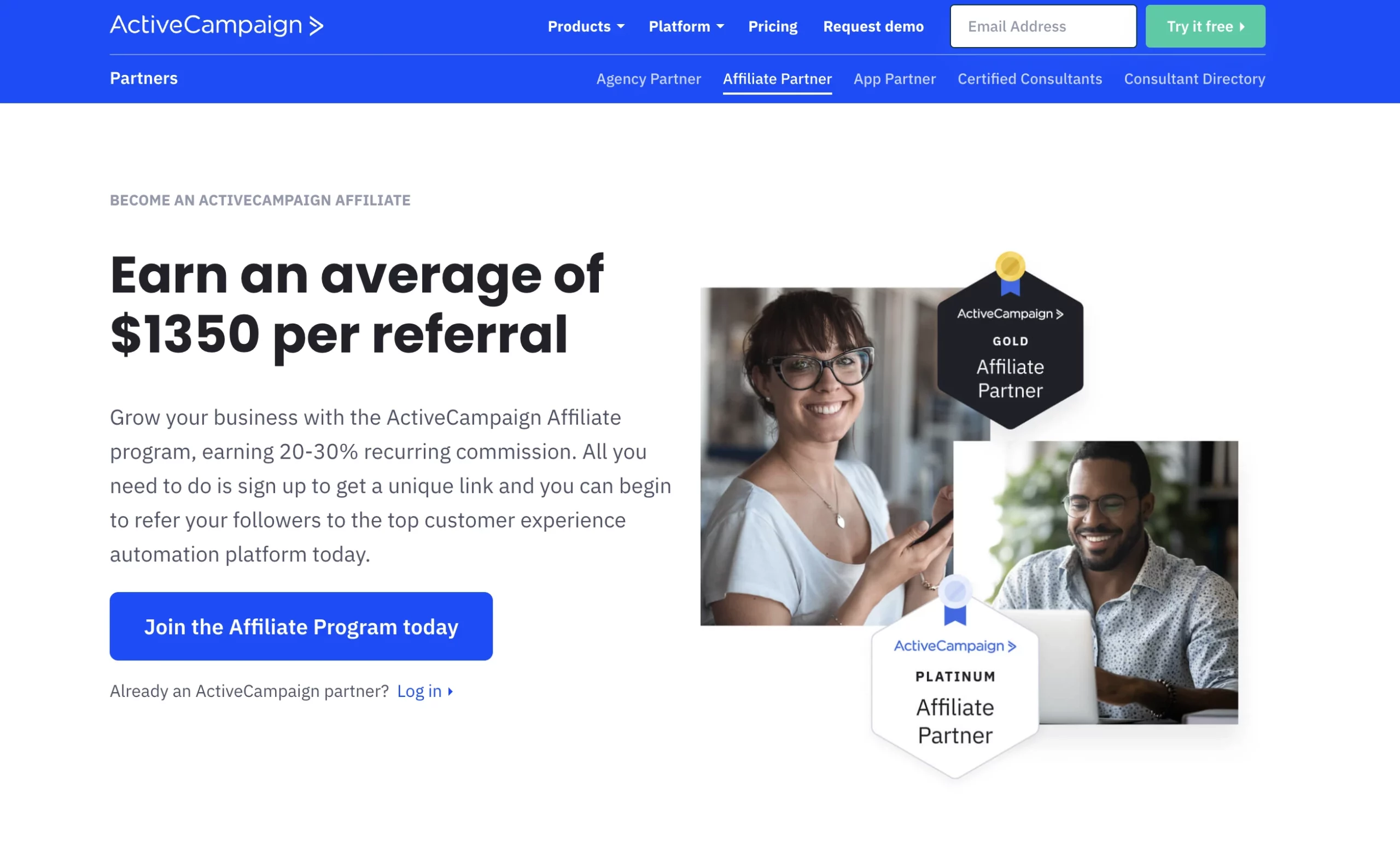
👀 Description: This program empowers content creators and marketing professionals to earn commissions by recommending ActiveCampaign, a leading customer experience automation platform.
✍️ Tracking: ActiveCampaign uses cookies to track referrals for a pretty standard 90 days.
💁 Recruitment: Here is how ActiveCampaign highlights their benefits to boost the recruitment of their affiliate marketing business:
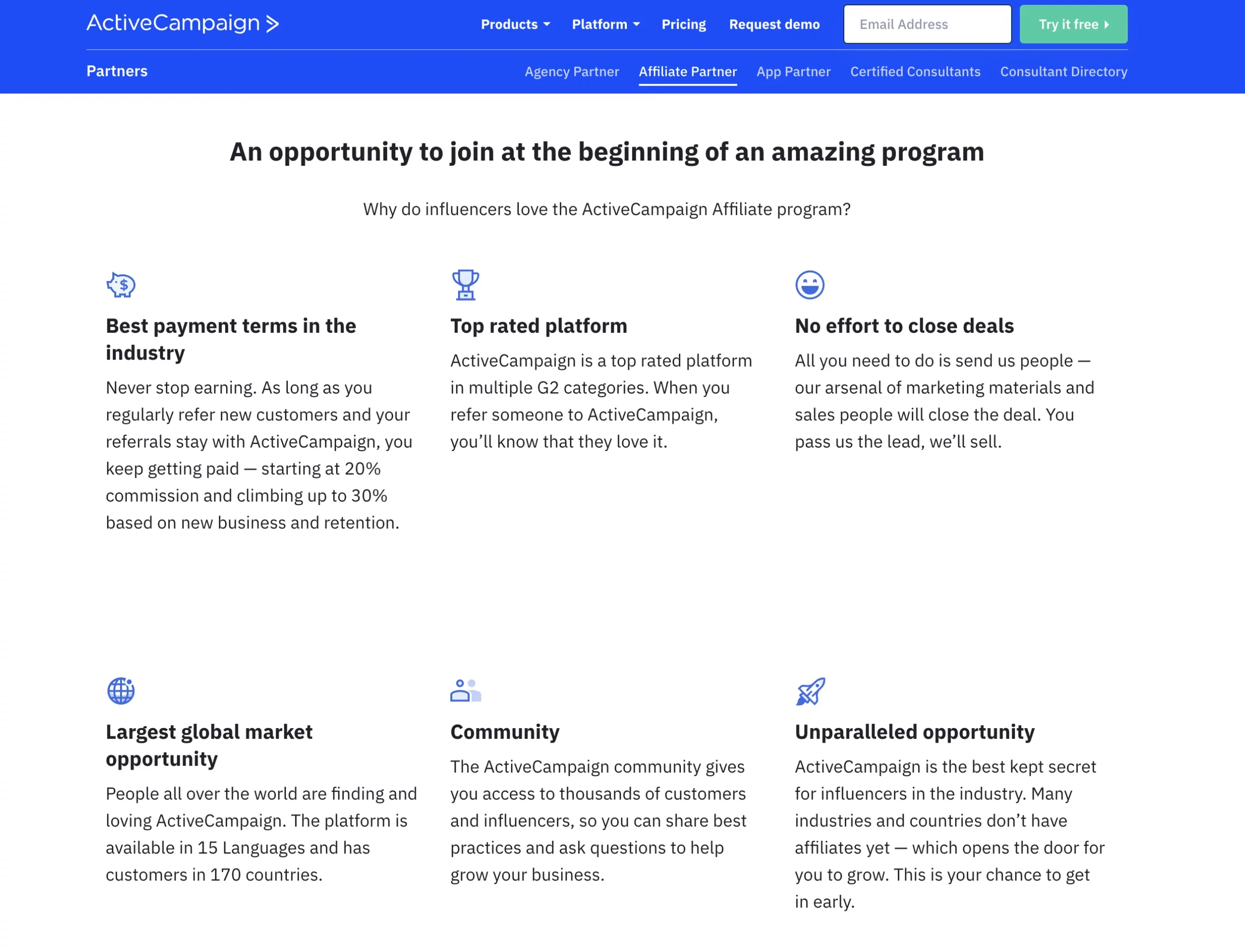
One more thing – affiliates receive a comprehensive pack of materials to keep going:
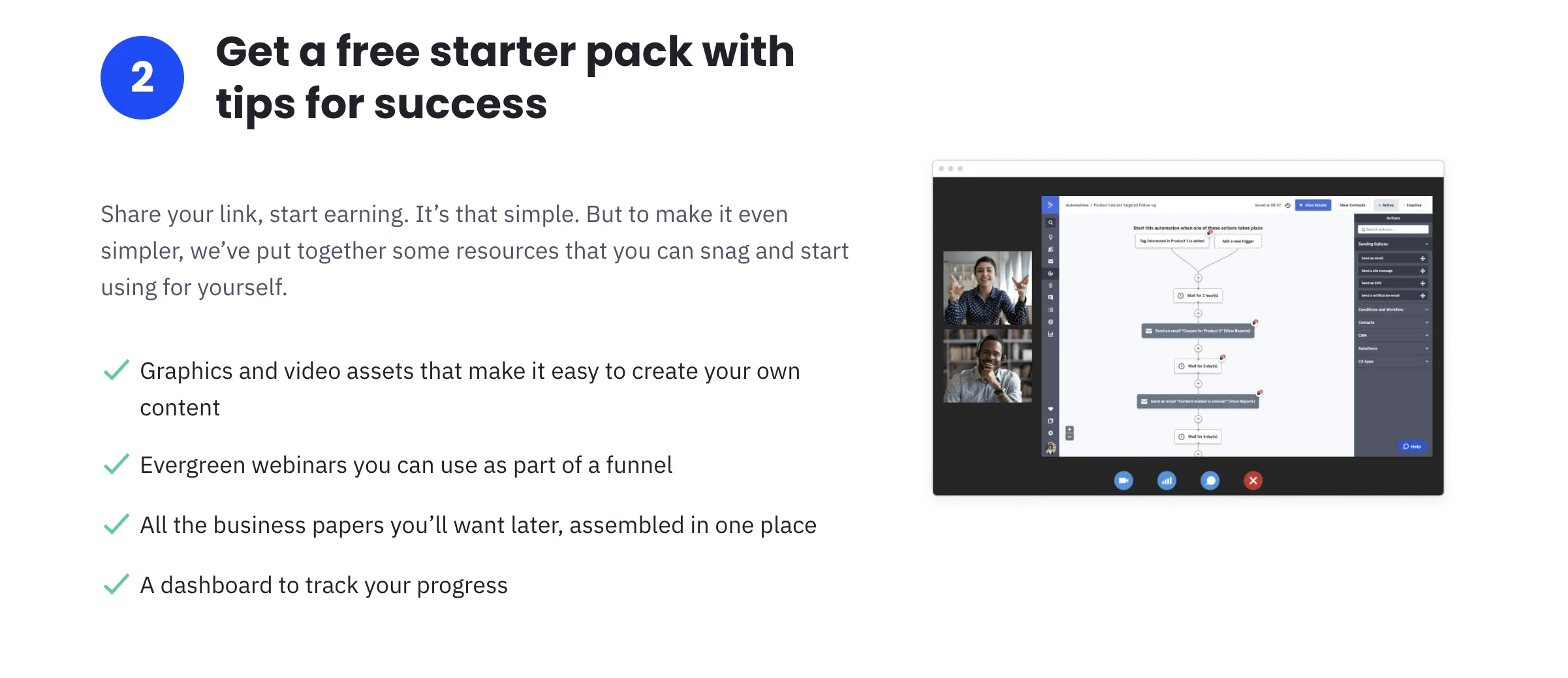
💵 Payouts: The program boasts a tiered commission structure, with affiliates earning:
→ 20% recurring commission: For every monthly or annual plan payment generated (for as long as the customer remains subscribed).
→ Potential for increased commissions: High-performing affiliates can climb the program tiers, unlocking even higher commission rates (up to 30%). In this regard, ActiveCampaign offers one of the best affiliate programs.
According to their affiliate site, the average affiliate earns $1,350 per referral, and there are affiliates in the program earning hundreds of thousands of dollars every month.
💡 Why does it work so well? The first reason for the success of this affiliate campaign is that the revenue potential is very good here. The recurring commission structure allows affiliates to earn passive income over the long term, as they benefit from customer loyalty to ActiveCampaign.
Don’t underestimate the power of competitiveness either – if you have an opportunity to get higher commissions (and if it is up to 30%), you would try harder.
Plus, they cater to a specific audience of businesses seeking advanced email marketing and marketing automation solutions. So, it’s a very defined and specific segment. What else?
ActiveCampaign provides extensive resources and support for its affiliates. This includes dedicated affiliate managers, marketing materials, training sessions, and detailed analytics. Such support helps affiliates market the product effectively and optimize their campaigns for better performance.
Affiliate Marketing Programs in Other Industries
So, after taking a close look at the best examples in e-commerce and SaaS, you must be thinking that these kinds of businesses are best positioned for running affiliate marketing programs.
Let us tell you a secret – affiliate programs are good for ANY type of business. While these two are most common, it doesn’t mean that your business can’t get the same benefits (or even better ones!)
Here are just a couple of examples to prove this.
Example #7: SunPower
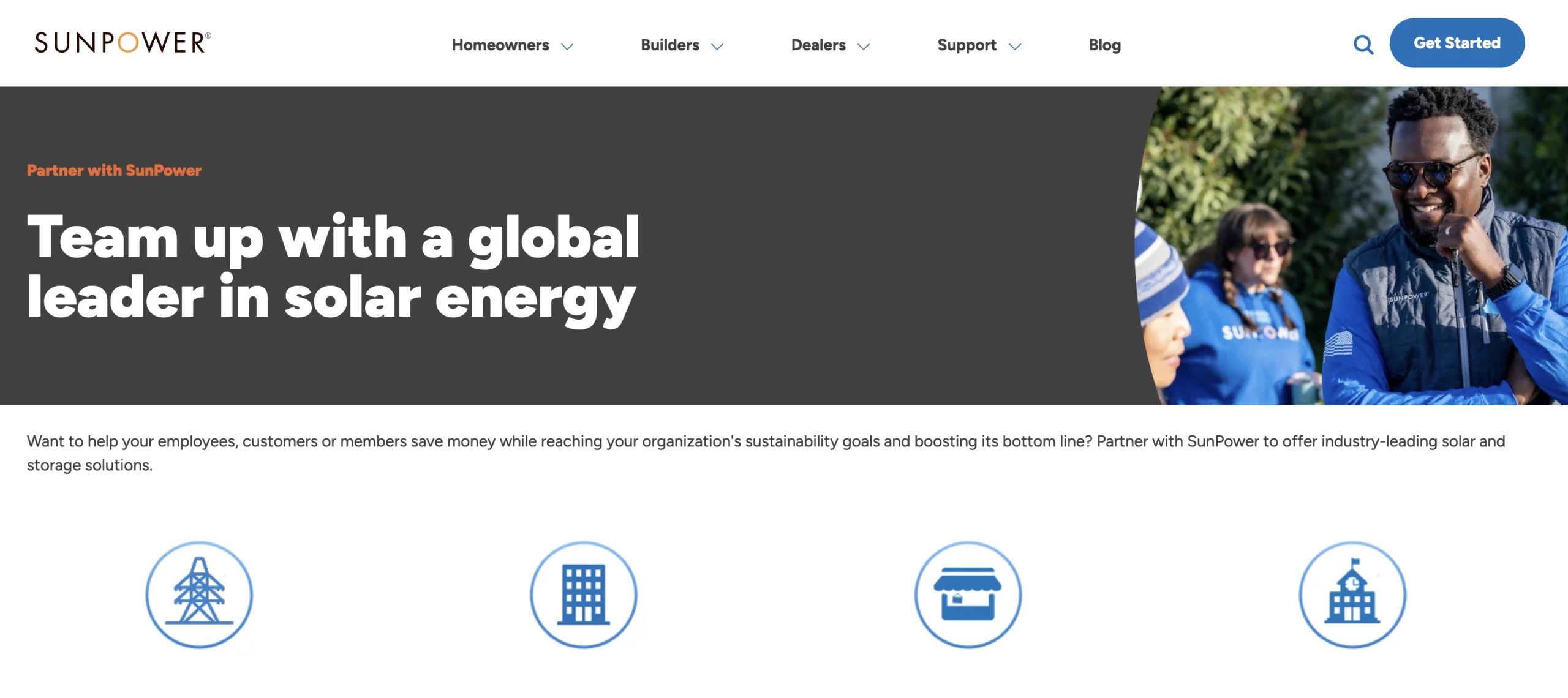
👀Description: SunPower affiliates promote the company’s high-efficiency solar panels and installation services. Affiliates can leverage various marketing materials, including:
- Educational resources on solar energy benefits
- Customer testimonials showcasing cost savings and environmental impact
- Case studies highlighting successful solar installations for similar organizations
💁 Recruitment: Let’s start with the noble reasons for recruitment here. So, affiliates not only earn (that’s not the noble part, wait for it) but also invest in a green future, which seems like a very obvious need for most people today. So, this part is all about values.
Then comes the commission rate – for a new lead, it is a generous $75. But that’s not all. What is most appealing is how they reevaluate who can be an affiliate. Ordinarily, these are bloggers, influencers, and content creators. What is different about SunPower?
They target utility companies, employers, education workers, and nonprofits. This is an amazing way to make your customer base way bigger and may be a good reference for your affiliate marketing website.
For example, you can target more segments, including employers, who, in turn, will spread the word to their employees. Or you could look to your existing customers and turn them into your affiliates.
In addition, maybe you can also communicate your values and mission through your affiliate program.
✍️ Tracking: By clicking a unique link, SunPower can track leads generated by each partner organization. Cookie duration is 45 days.
💵 Payouts: $75 per lead.
💡 Why does it work so well? SunPower’s affiliate program is successful for several reasons:
✔️ Targeted approach: Focusing on specific partner groups allows for tailored marketing messages and a more efficient program. Plus, since they find multiple audience segments viable for their affiliate program, it is easier to make the whole program work.
What can you pick up from this approach? First, this precision in targeting different groups of people ensures that their affiliates are not just spreading a generic message, but one that truly speaks to the needs and interests of their audience.
Secondly, it opens up an important thing: we can extend our definition of affiliates as far as possible.
✔️ Strong value proposition: SunPower offers a premium product with a clear environmental benefit, which resonates well with its target audience.
✔️ Promoting values: Affiliates earn commissions while promoting sustainability, and SunPower gains access to a wider audience. People connect not just based on something tangible but on building a better future.
That’s a good tendency, and it doesn’t mean you have to use it for your own benefit, but if there’s a larger value behind your product, don’t hesitate to put an emphasis on it.
Example #8: AirAsia

👀 Description: AirAsia’s affiliate program allows anyone to earn commission from the sales they generate. While this is already the biggest air company in Asia, they’re still actively promoting their affiliate campaign.
💁 Recruitment: According to their site, here is why affiliates should join this affiliate program:
- Simple, one-time sign-up process.
- Earn up to 9% of commission on a variety of products and services.
- Earn extra income immediately.
AirAsia welcomes anyone who creates content that inspires wanderlust. Whether it is a travel blogger with a dedicated audience or a social media influencer with a knack for capturing travel experiences, they can apply to join the program.
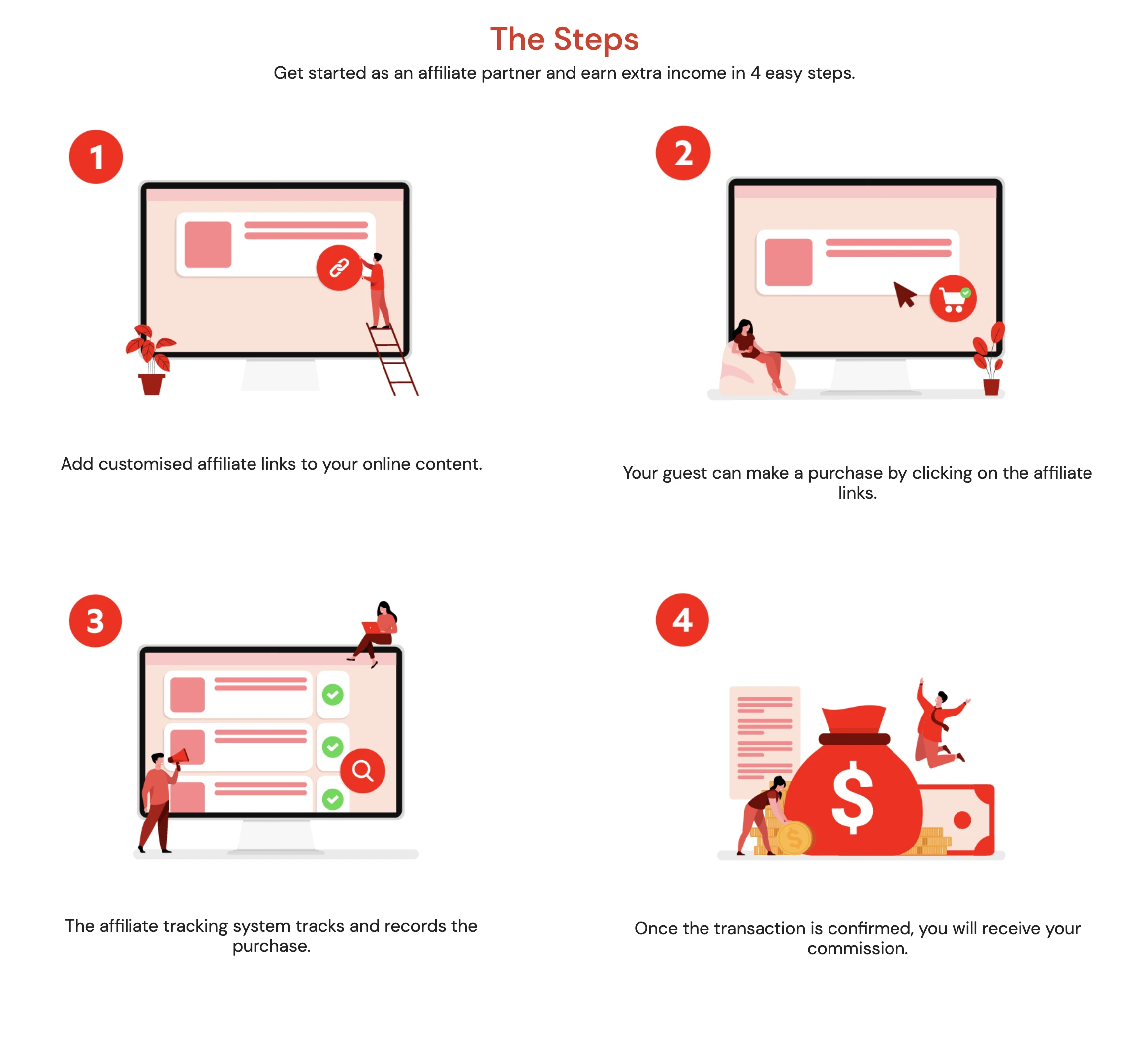
This open approach allows a diverse range of creators to participate and promote AirAsia’s destinations. Remember how we mentioned that marketing materials and support are vital for a great affiliate program? AirAsia offers them right away:
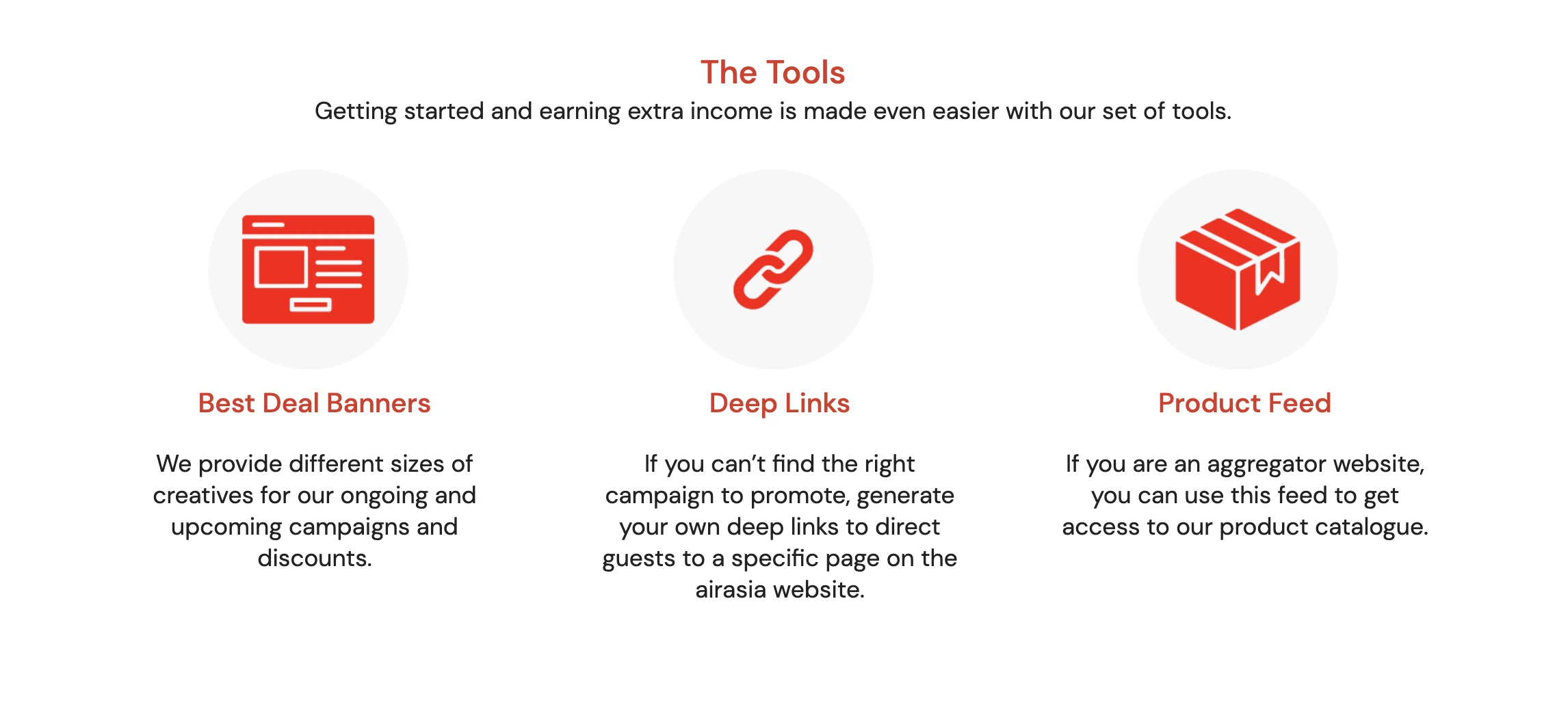
✍️ Tracking: Once approved, you’ll receive your unique affiliate links to use when promoting AirAsia flights, hotels, and other travel packages. AirAsia utilizes cookies to track referrals for 30 days. Affiliates get credit even if potential travelers take some time to browse destinations, compare prices, and ultimately book their flights through AirAsia.
💵 Payouts: Up to 9% of commission on a variety of products and services.
💡 Why does it work so well? Several factors contribute to the success of the AirAsia Affiliate Program. Firstly, the program caters to a broad audience with its focus on affordable travel. Who doesn’t need that today?
With globalization, traveling has become a necessity rather than the luxury it used to be. That’s why AirAsia’s messaging resonates with budget-conscious travelers and backpackers, a large and active demographic in the online travel community.
Secondly, AirAsia’s strong brand recognition adds credibility to affiliate promotions. Partnering with a reputable airline like AirAsia instills trust in your audience.
Example #9: Liberty Mutual

👀 Description: The insurance industry might be less known for its affiliate programs, but since there are many examples, we can only say this much: affiliate marketing works for EVERY business. Liberty Mutual is one of the biggest property and casualty insurers in the U.S.
💁 Recruitment: Here’s what benefits we can see offered by this affiliate program:
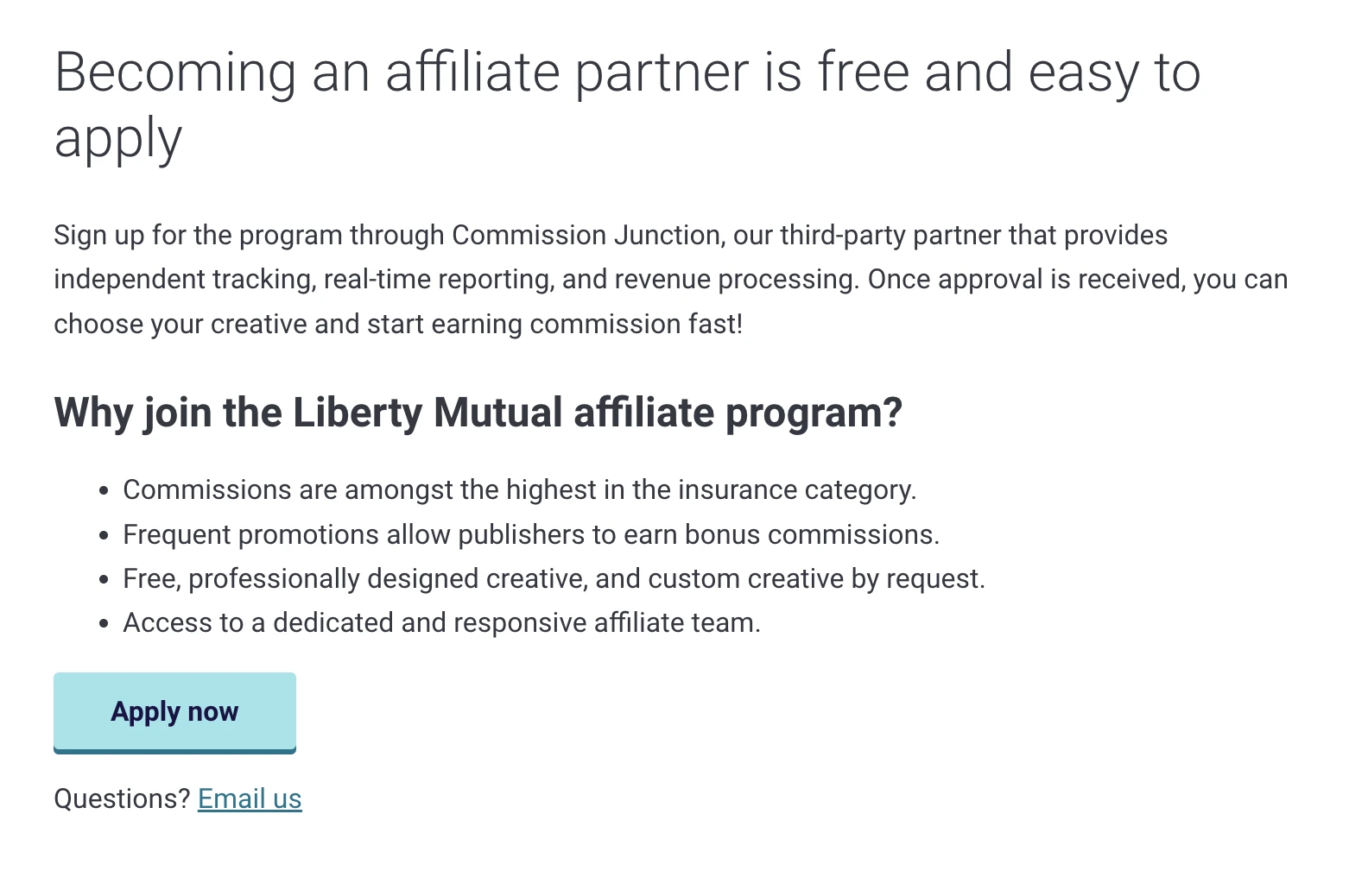
✍️ Tracking: They use a simple link tracking system. Instead of going to a digital checkout page, links go to customized lead generation forms, where potential new customers can register their interest and move into the pipeline.
💵 Payouts: Their reward structure works as follows:
- $10 for a new lead in auto and home insurance.
- $3 for renters insurance.
💡Why does it work so well? A combination of creatives, marketing materials, and a constant need for insurance (aka a high demand) makes this program appealing to many clients.
How To Launch An Affiliate Program For Your Business
After seeing so many examples, it is probably clear now – building a successful affiliate program can be a game-changer for your business. It allows you to leverage the reach and influence of others to promote your products or services and drive sales. But where do you actually start?
Let’s go through the following checklist to help you build and launch your affiliate program:
#1 Make Sure Your Business Needs an Affiliate Program
This is the first step, and it is important that you consider your situation. Many businesses start affiliate marketing programs when they should rather, for example, opt for a client referral program. So, what you have to do is to analyze your business model and see if it is a fit.
To understand the whole idea of an affiliate program, you might want to understand the affiliate marketing cycle:
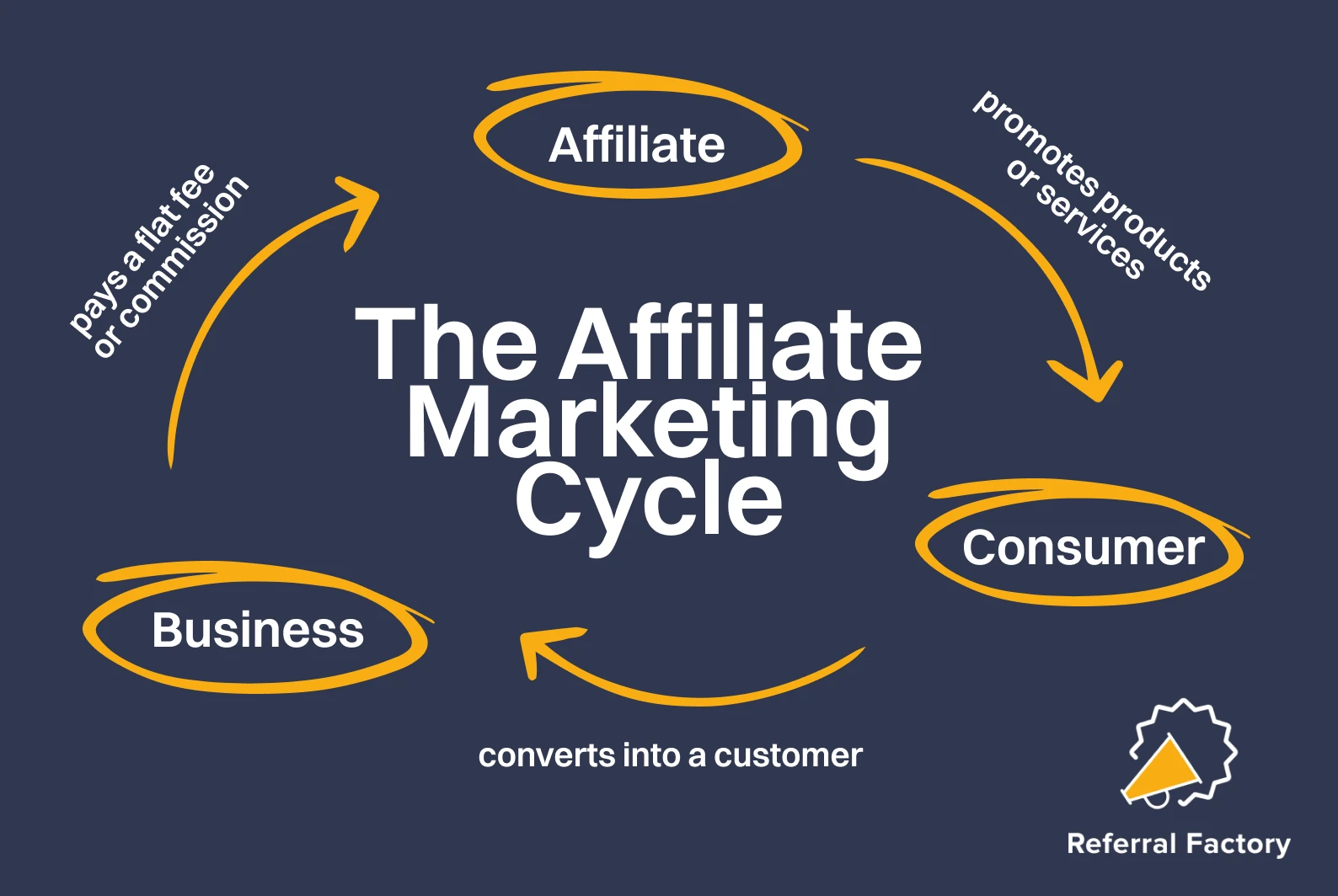
Here’s how it works:
👉 The cycle starts with the affiliate, who could be a blogger, influencer, or anyone with enough traffic to their own website, social media channel or a large enough network to recommend you to. Affiliates promote the business’s products or services through various channels like social media, blogs, or email marketing instruments. Their goal is to drive traffic and conversions to the business.
👉 Consumers are the target audience that encounters the affiliate’s promotional content. When they click on the affiliate link and decide to purchase the promoted product or service, they are converted into customers. This step is crucial as it transforms engagement into actionable sales.
👉 The business benefits from the affiliate marketing efforts by gaining new customers. It tracks these conversions back to the affiliate through unique affiliate links, recognizing the affiliate’s contribution. In return, this increased customer base can lead to higher revenue and brand growth.
👉 As a “thank you” for their efforts, the business compensates the affiliate. This payment could be a flat fee per conversion or a commission based on a percentage of the sale.
#2 Calculate How Much You Can Actually Pay
Earlier, we said that the best affiliate marketing programs offer high commissions. But what can your business afford? It’s important not to overstep here; find a balance. Use this formula:

There are many successful affiliate programs that started out with small payouts and grew over time. So, don’t rush into the biggest commission right from the start, give it time.
Also, don’t try to compete with the highest paying affiliate programs if it doesn’t fit into your budget. If you are strategic, you will get there over time.
Consider this: even Amazon Associates doesn’t pay the biggest commissions in the industry. Even if an affiliate program offers good deals for bloggers, your first concern should be the business itself.
#3 Choose the Right Software
A proper referral tracking tool is a crucial point of your journey to create an efficient affiliate program. Choose software that is easy to use (for you and your affiliates) and has everything you need, from a proper tracking system and ready-to-use templates to a great reporting system.
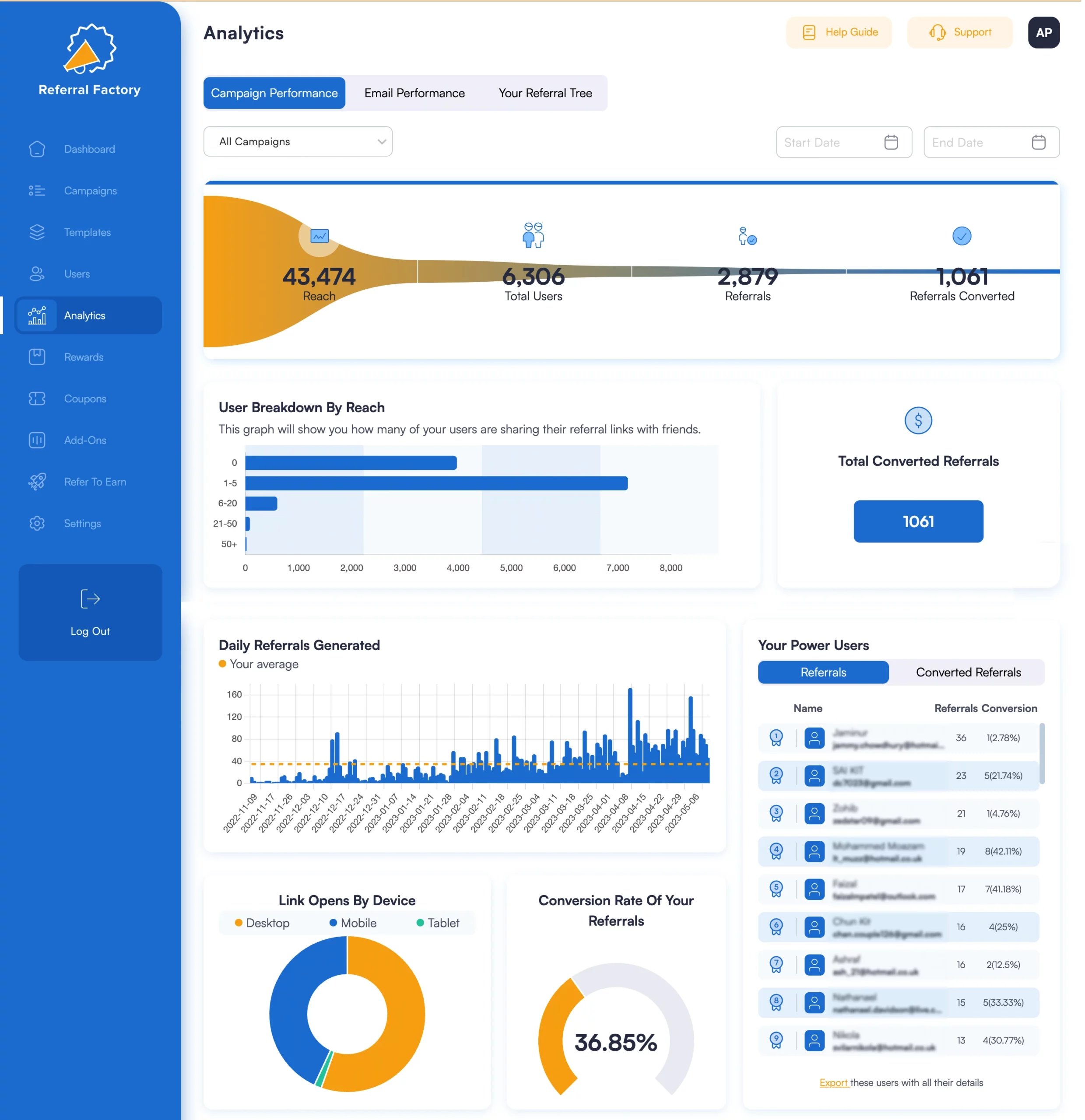
Whether you are launching an affiliate program for your pet store or your web hosting SaaS, robust and easy-to-use software is non-negotiable. Plus, as your affiliate program expands, the software should be able to handle increased traffic and more affiliates without compromising performance.
#4 Define Your Goals
Yep, another typical step, but a vital one! What do you want to achieve with your affiliate program? Increased sales, improved brand awareness, or higher customer retention?
Setting specific, measurable goals will help you track your program’s success and make necessary adjustments along the way. For instance, aim for a 20% increase in sales within the first six months or a 30% growth in affiliate sign-ups in the first quarter.
#5 Create and Post Affiliate Resources
As you know, you need to create and add a lot of marketing resources. This includes high-quality banners, social media templates, email scripts, and detailed product information. Highlight what exactly your affiliate program offers. Amazon’s affiliate marketing program is a good reference for this.
The more professional and easy-to-use these resources are, the more likely your affiliates will use them effectively. Remember, the success of your affiliates directly impacts your program’s success. Try to give them everything they need to promote your products confidently and efficiently.
#6 Onboard Your Affiliates
Or rather, create onboarding materials for them. What can that be?
👉 Give them clear instructions and resources to understand your program and promote your products/services effectively; these are usually placed on your dedicated landing pages and affiliate sites.
👉 Create program guidelines, marketing materials, creatives (banners, social media posts), and promotional product information.
👉 Consider hosting a webinar, training session, or other online courses to educate affiliates about your brand and products.
As you see, you can use it any way you want as long as it serves its purpose. By helping affiliates in promoting, you make a very powerful investment in your program’s future. This can even lure other affiliates from other affiliate networks or campaigns.
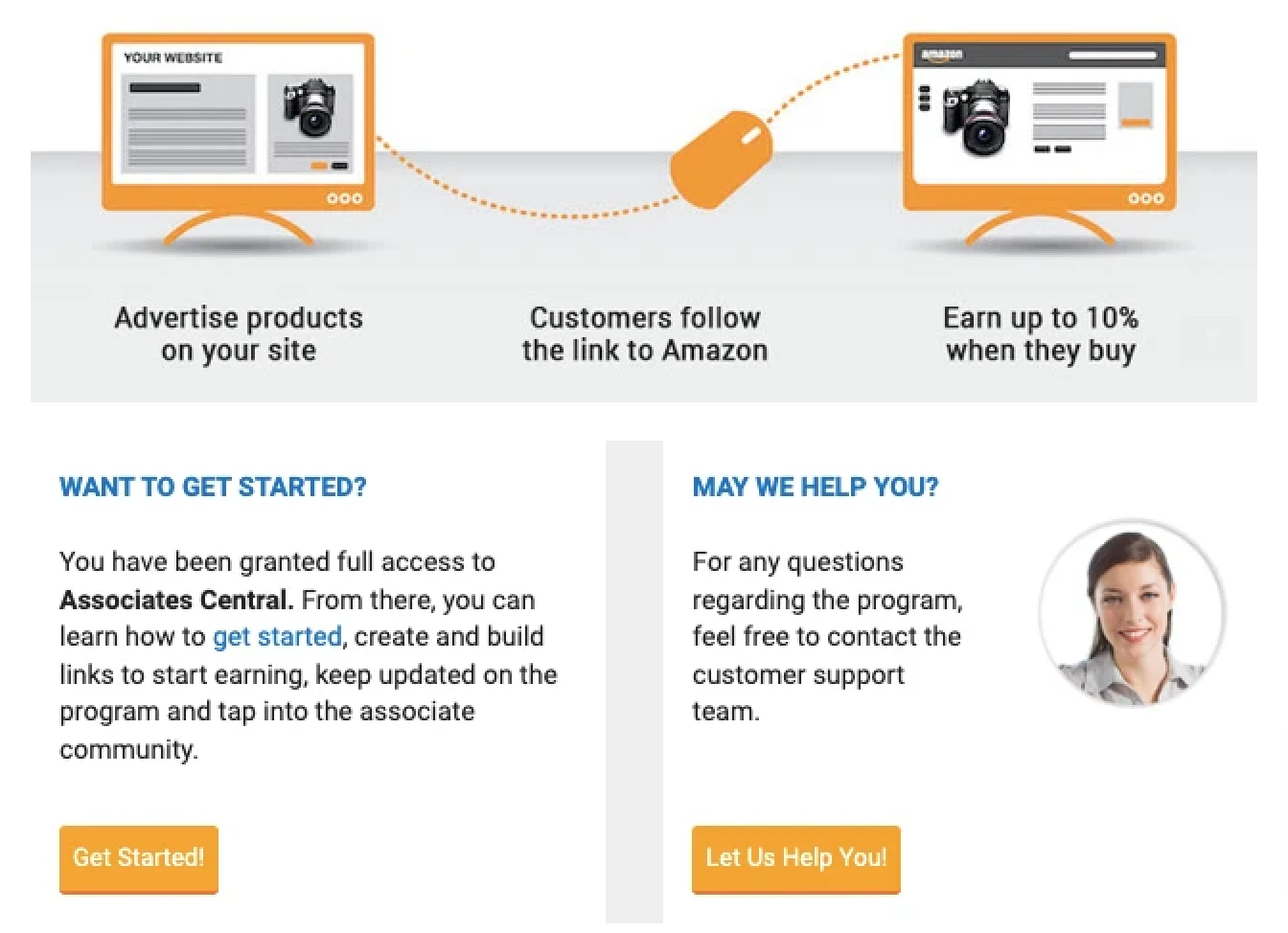
#7 Promote Your Affiliate Program (As Much As Possible!)
Potential affiliates need to hear about you. Maybe they would gladly generate affiliate links and promote your business, but they simply don’t know your program exists. All top affiliate programs spread the word about their campaigns, even if they’re already successful!
How should you announce your campaign, then? Here are just a few ideas of what you can do:
- Announce the launch of your program through your website, social media channels, and email marketing campaigns.
- Encourage existing customers to participate by highlighting the referral incentives.
- Consider influencer marketing campaigns or collaborating with other businesses to reach a wider audience.
- Add a pop-up that promotes your affiliate marketing program on your website.
- Go to other affiliate networks or forums to spread the word.
- Use email marketing.
- Adding some search engine optimization is also a good idea.
This is the last step before you actually launch your program. After this – just go onward and onward!
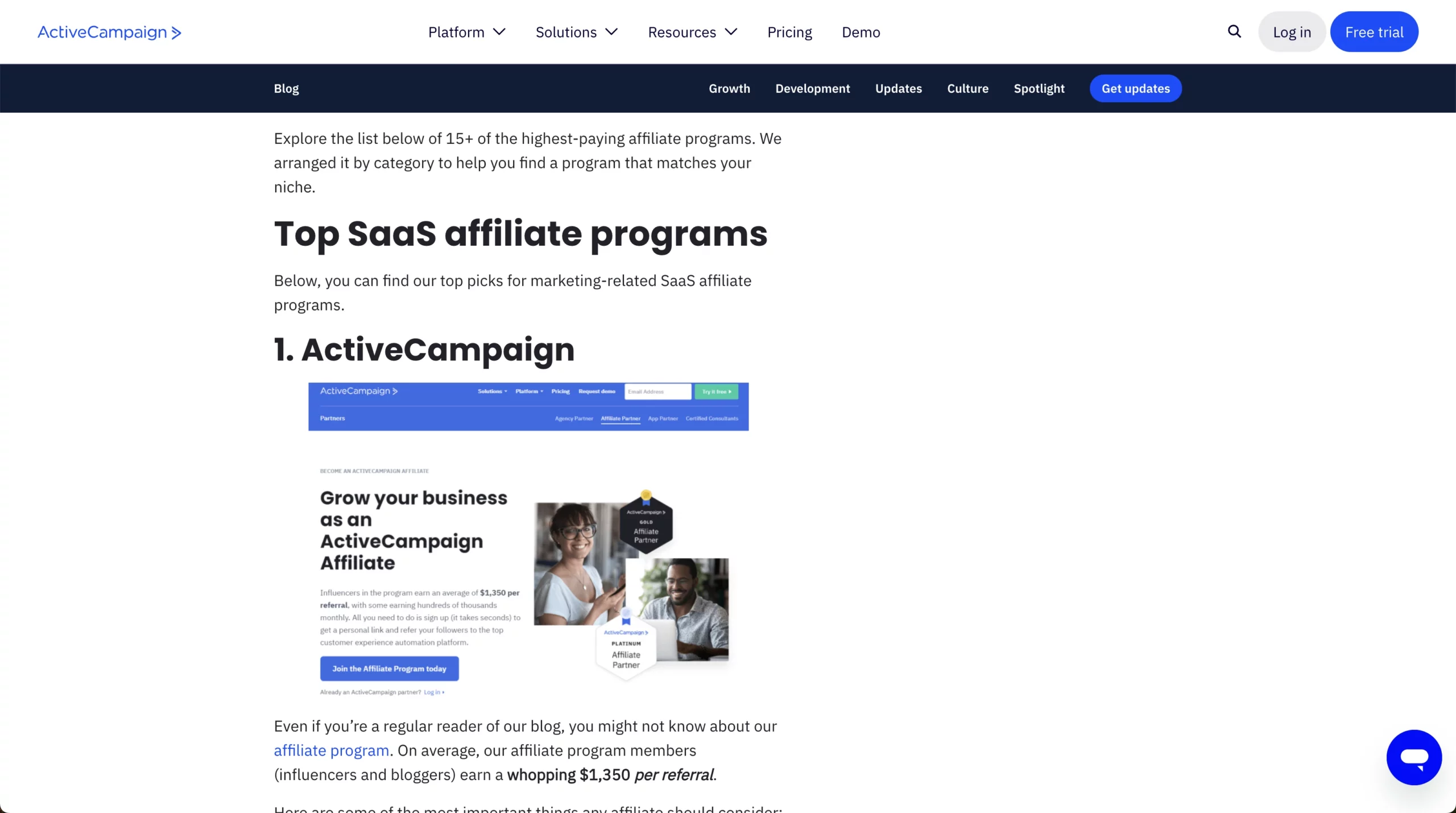
How to Build an Affiliate Program With Referral Factory
Even when you know all the basics, building an affiliate campaign from scratch requires at least some basic expertise. So, what should you do then? Of course, you can hire a developer to build a tracking system from scratch, but a faster and more cost-effective way to launch your own affiliate program is by using plug-and-play referral software. It will guide you through all the steps and take out the technical legwork.
Referral Factory, for example, does not require any previous experience as it has an easy interface both for you and for your affiliates. As I mentioned earlier, Referral Factory stands out as an alternative to expensive affiliate software because it doesn’t use unreliable cookies for tracking. That way, it works for e-commerce, SaaS and many other businesses alike!
Tracking is made even easier because Referral Factory has native, one-click integrations with other software that you already use to run your business, like CRMs (e.g., HubSpot, Salesforce, Zoho, etc.) as well as payment gateway software (e.g., Stripe).
Now, let’s see how you can create an affiliate campaign from scratch. When you sign in and go to the Campaigns tab, you will see that you can easily build your affiliate program by yourself or choose to start with one of the hundreds of pre-built templates.
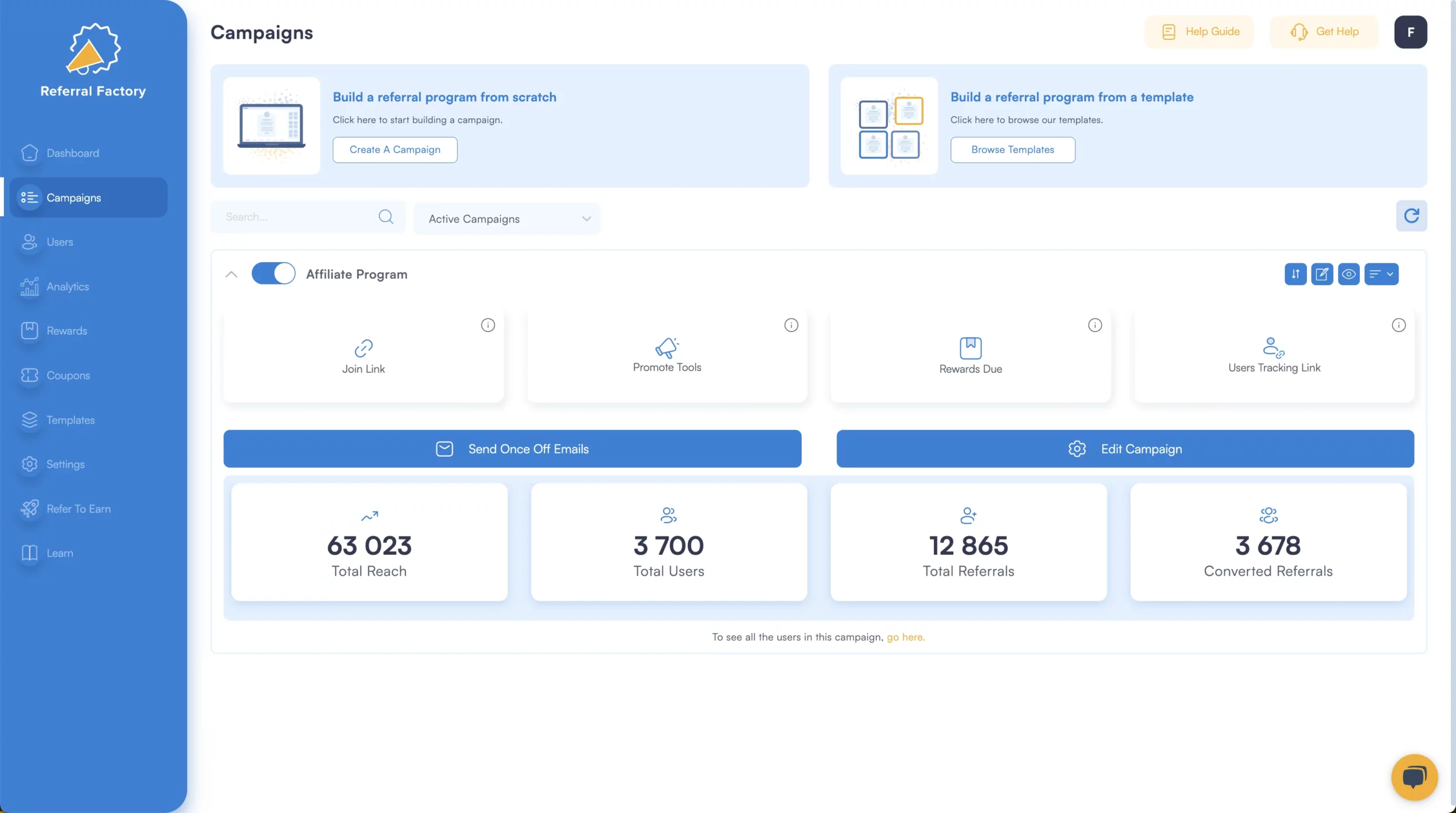
There are templates for pretty much any use case that can make the whole process easier for you:
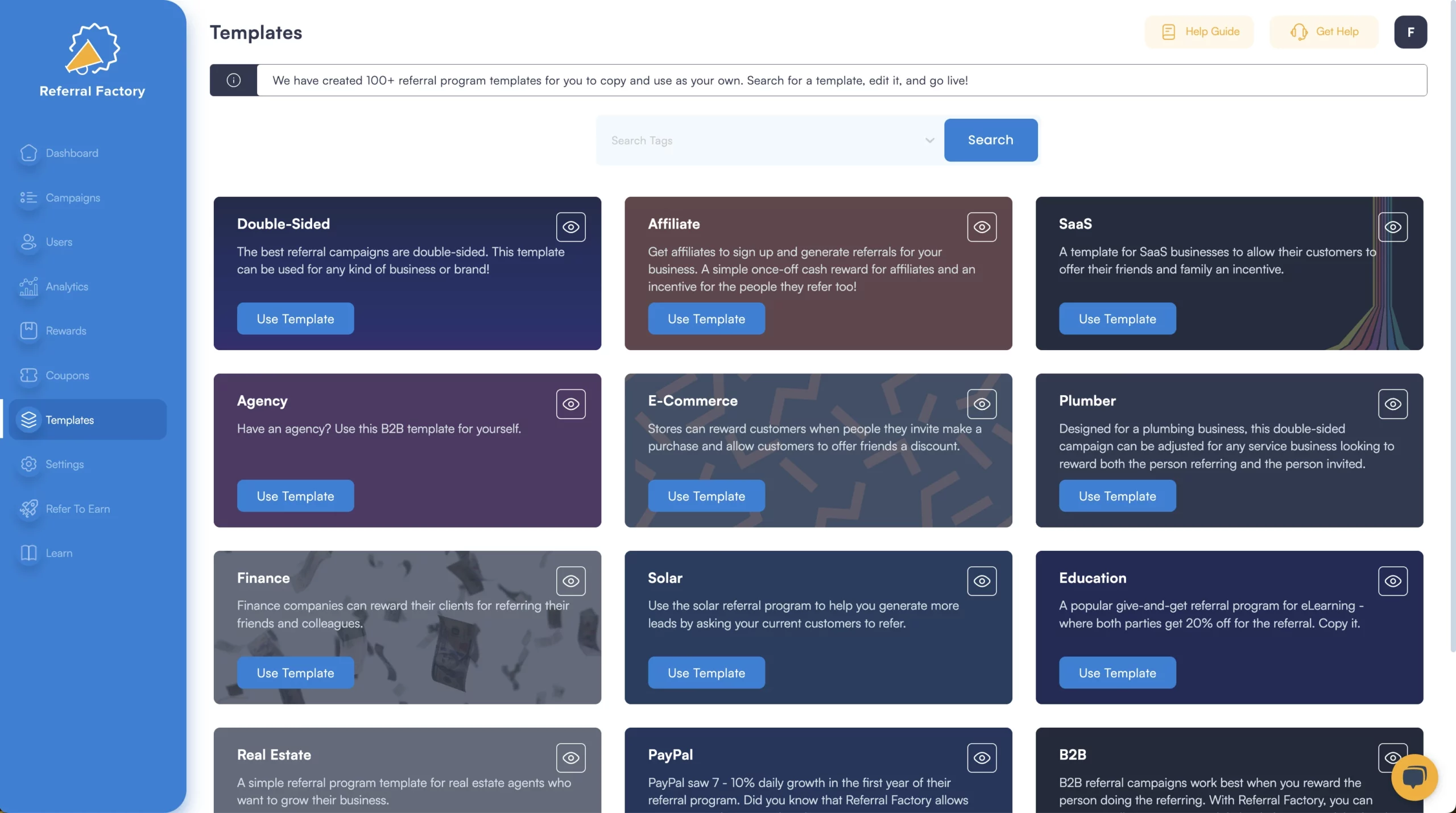
Let’s say you decided to use an affiliate template. In the next step, we recommend you work carefully on your pitch page for recruiting a potential affiliate. These pages can be embedded into your website or easily repackaged as a pop-up or widget.
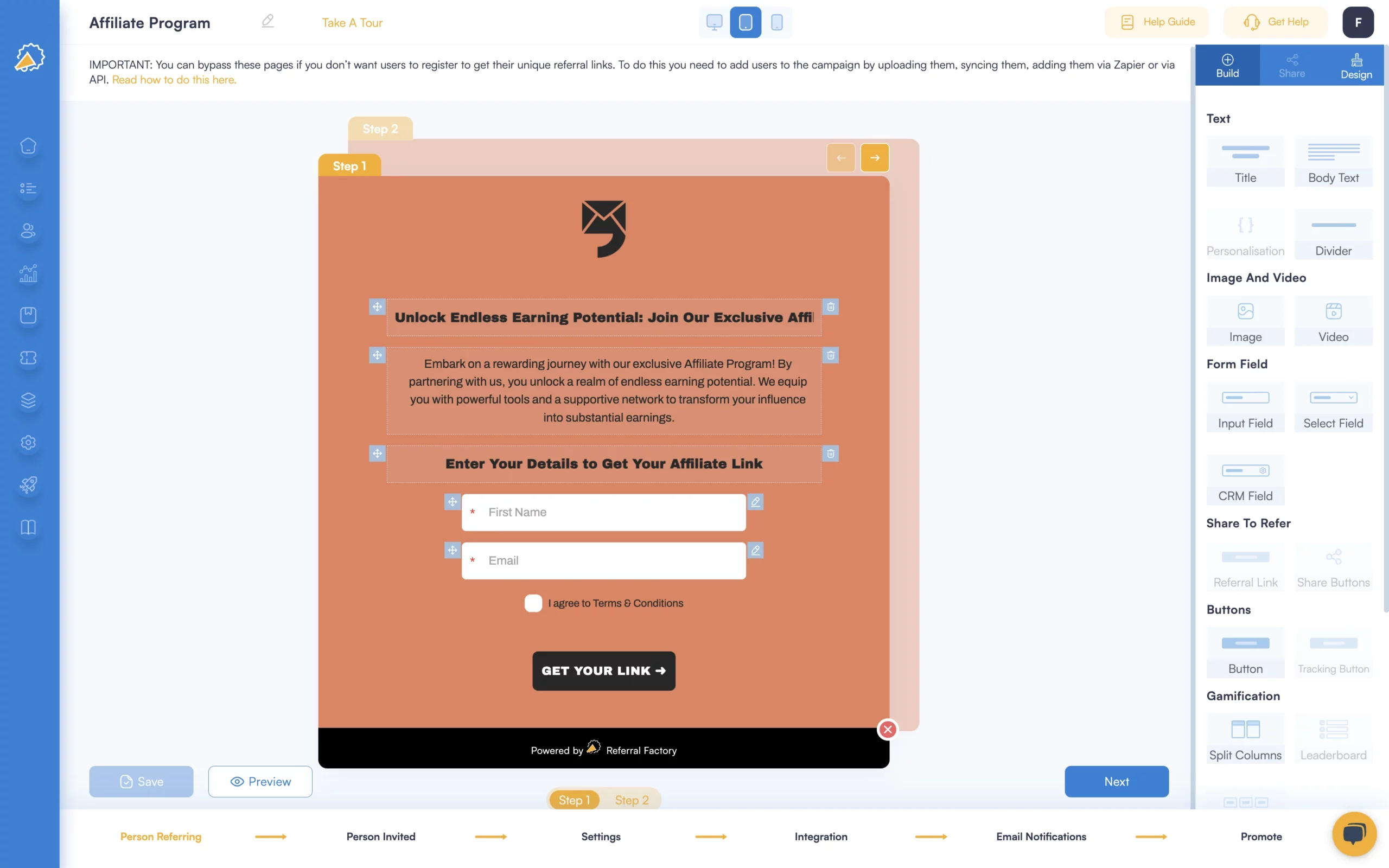
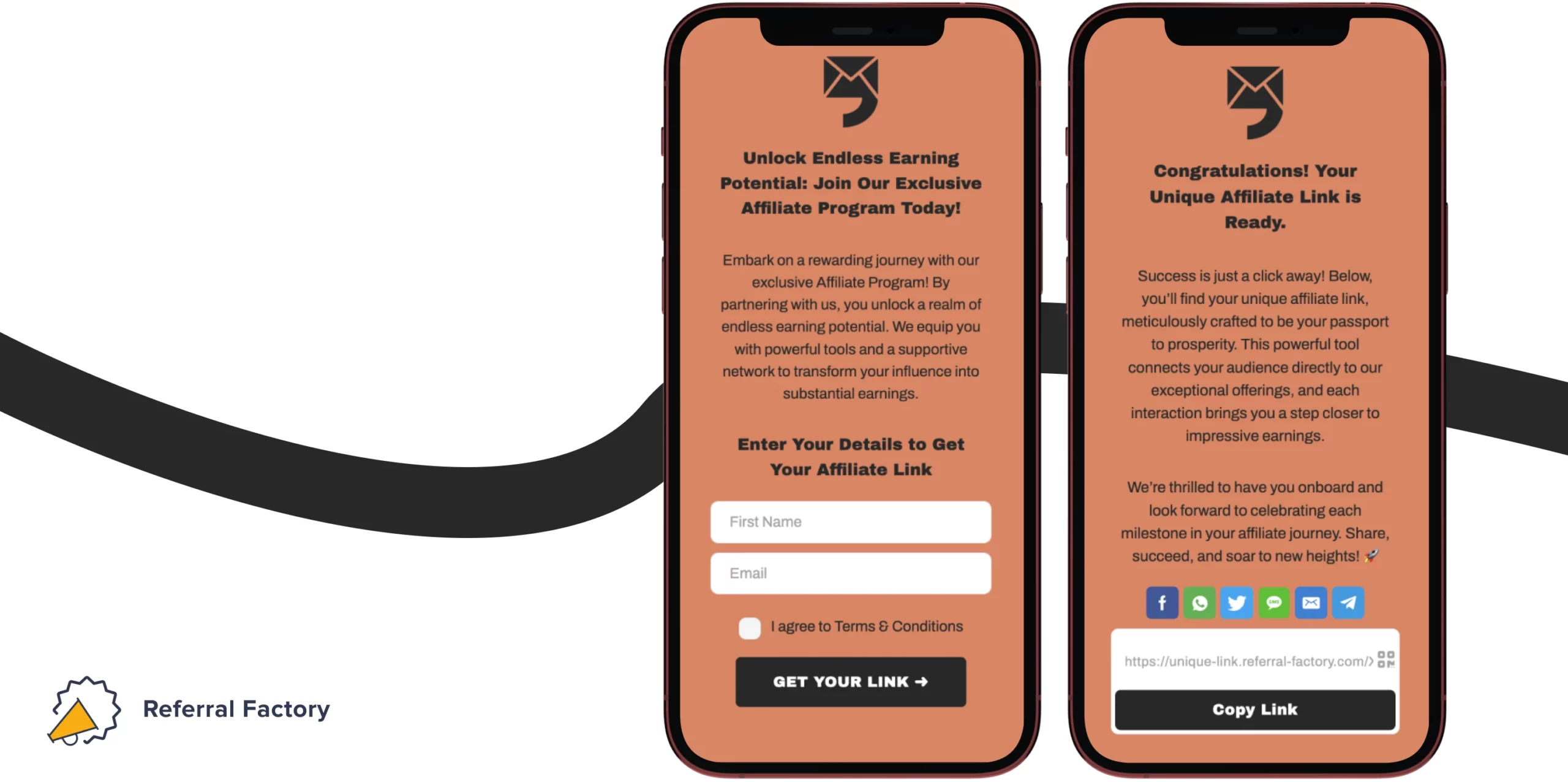
Next, optimize the lead generation form that opens when a potential new customer clicks on an affiliate link. This is how Referral Factory tracks leads, which means no cookies and you can offer new users a special offer, a discount code, and/or nurture leads over a longer sales cycle!
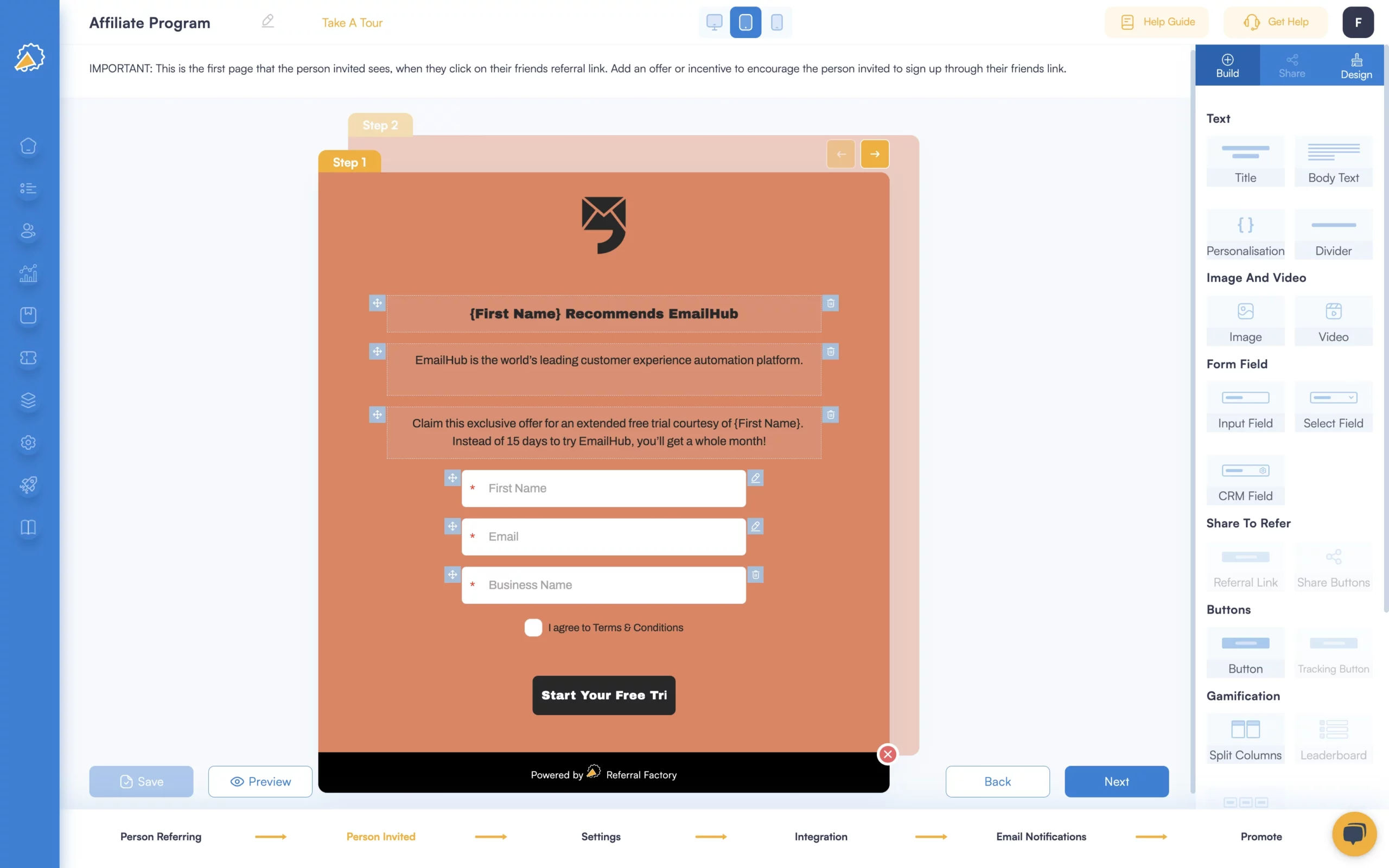
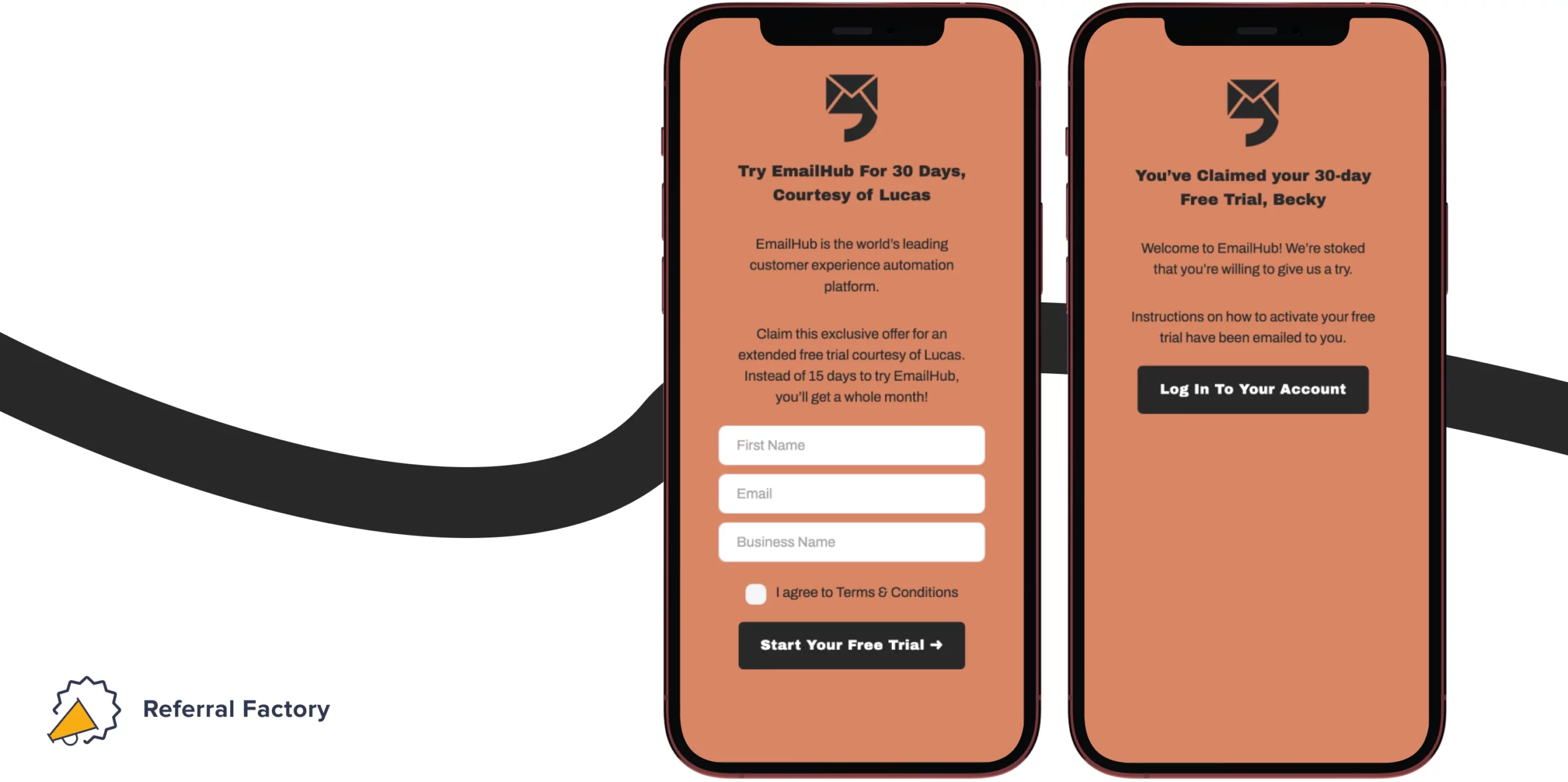
After this, work on your campaign settings, which is simply setting the “rules” for your program:
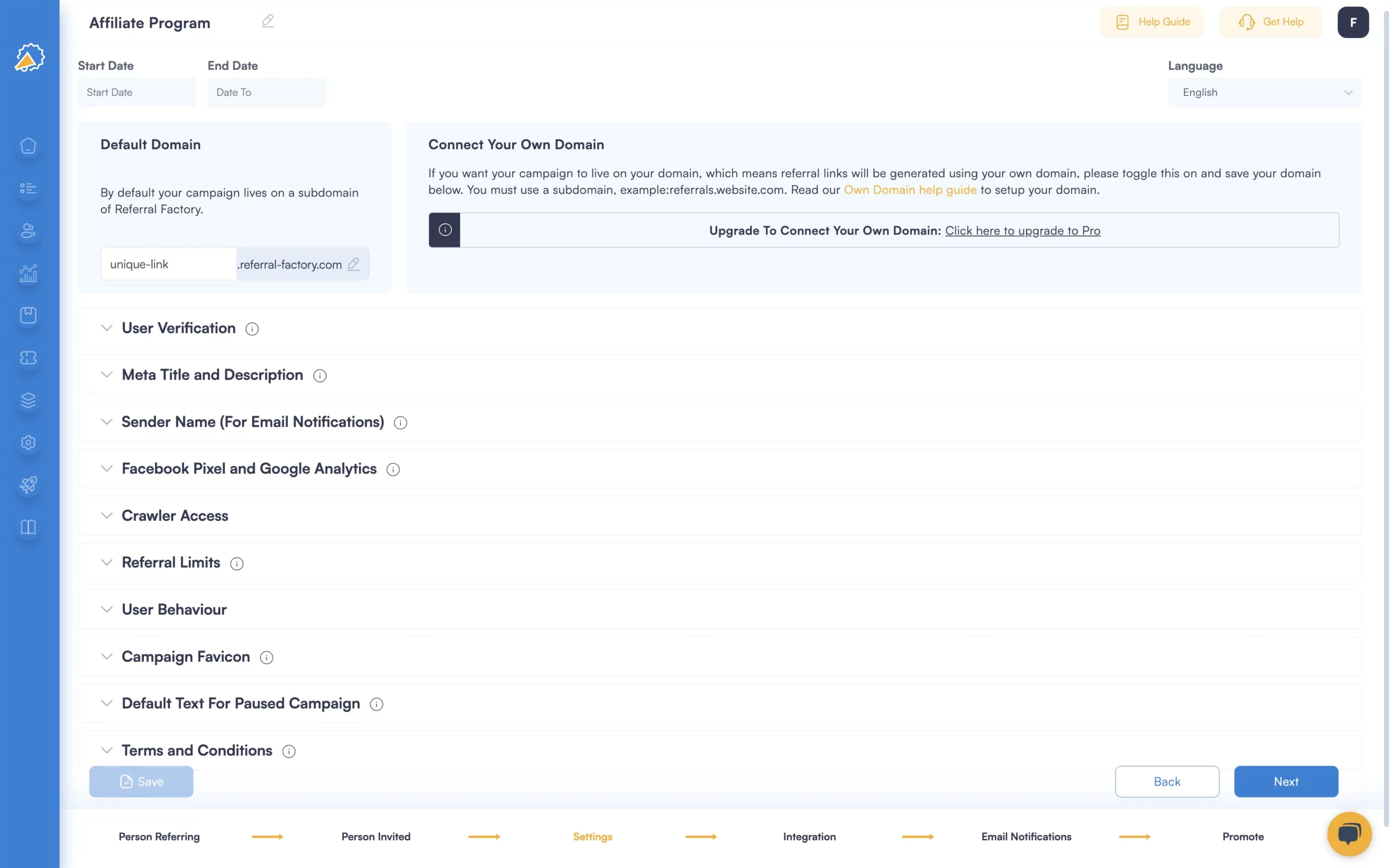
Then, you can connect integrations to streamline your workflow:
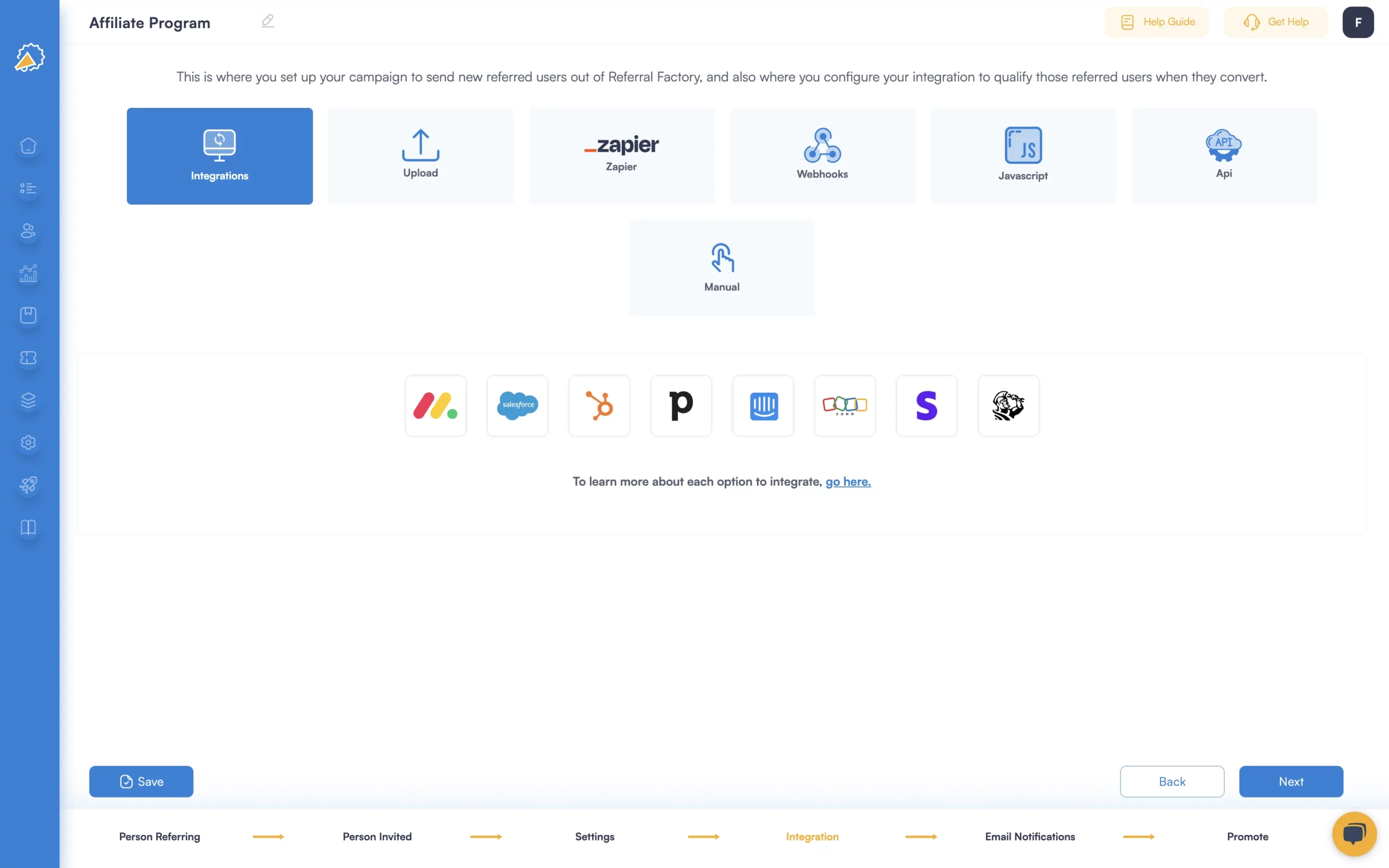
With built-in email notifications, you can keep affiliates and potential customers updated without any effort.
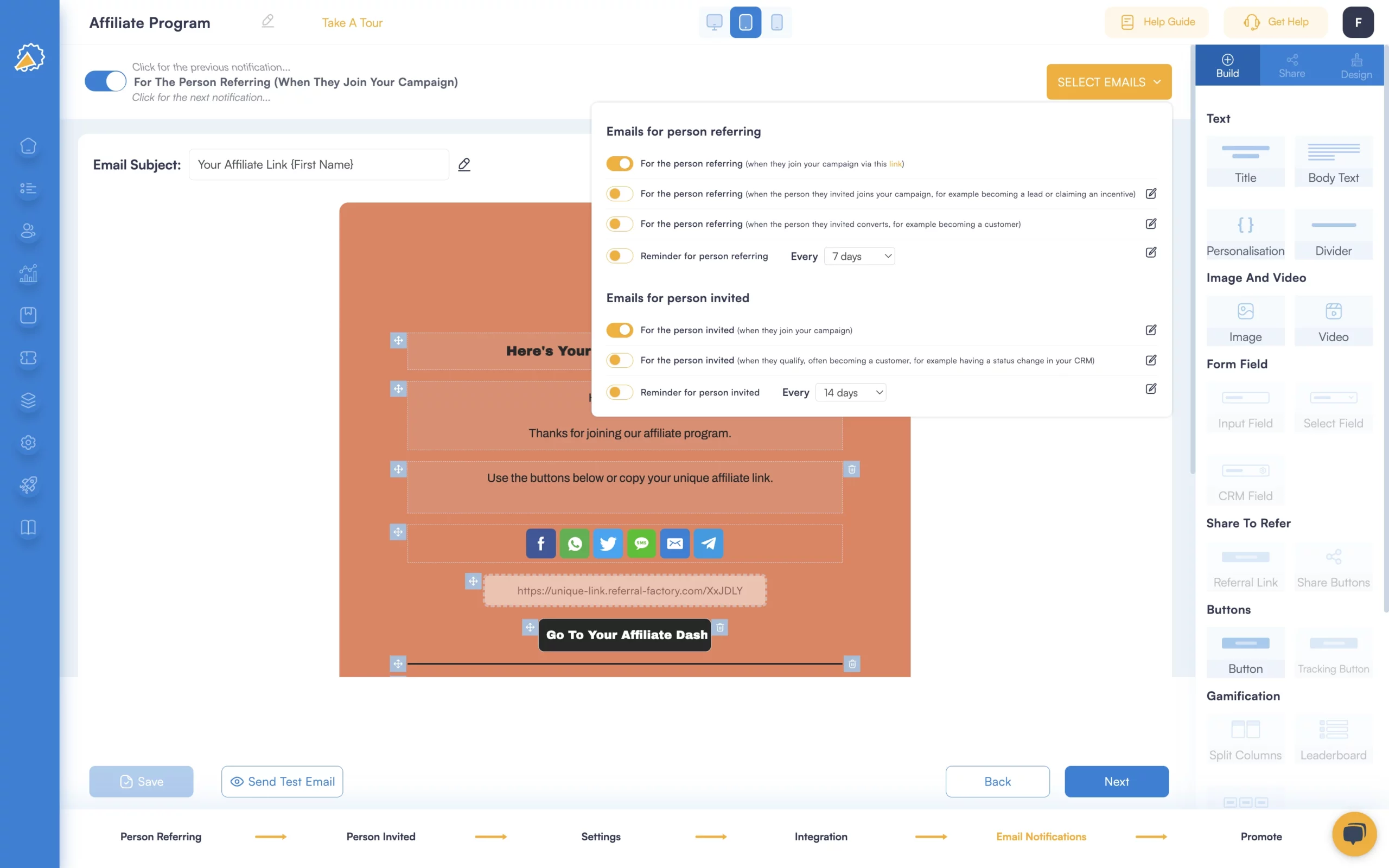
Once your affiliate campaign is ready, you can start promoting it! Note: We recommend using any available marketing channel for this. The more, the better!
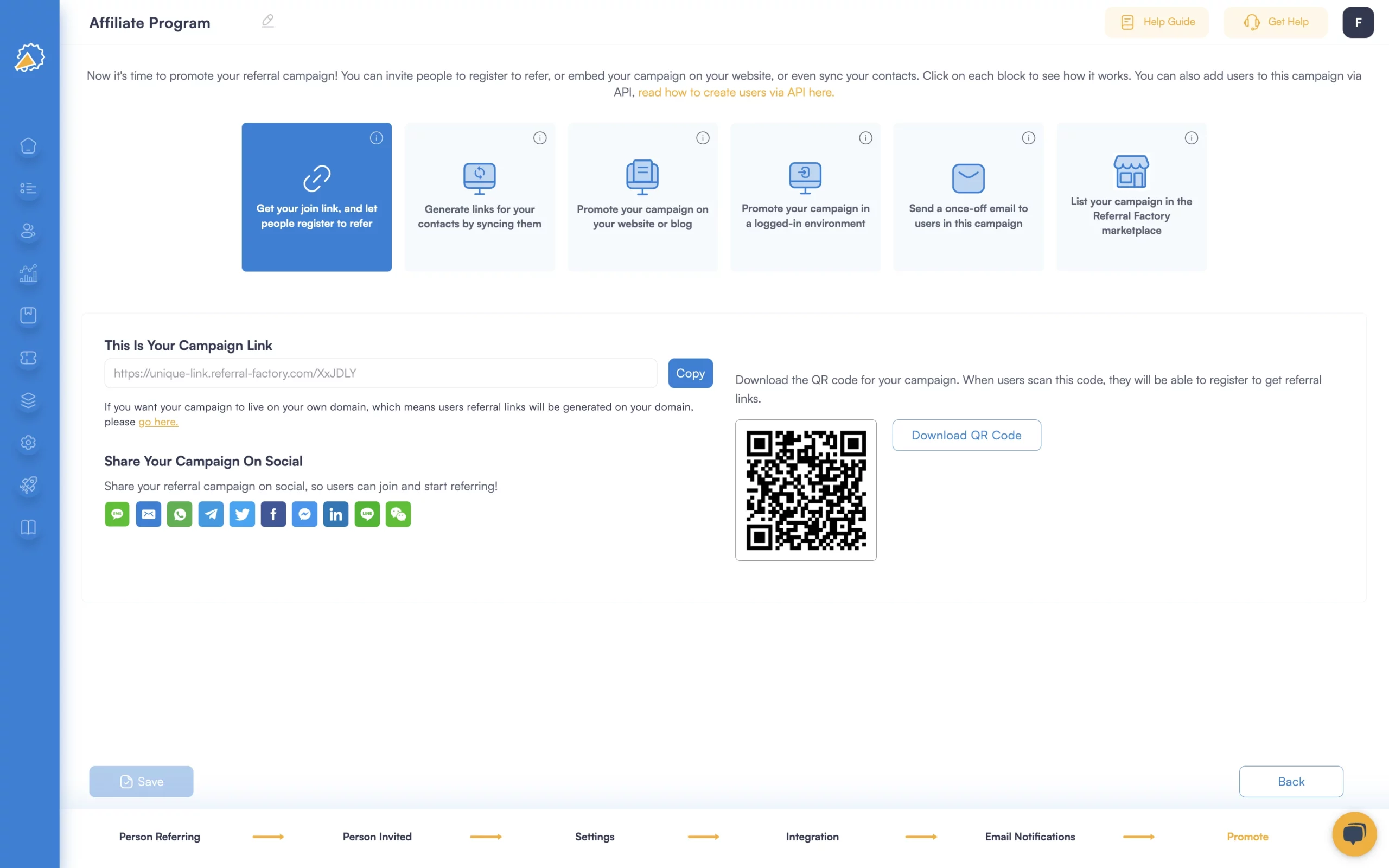
That’s it! Now, you can use it as an in-house affiliate program – you have complete control over every aspect of your campaign.
How To Recruit Affiliate Marketers
It seems like we’ve already talked so much about recruitment, but it’s for a reason. Look, you can create the most attractive campaign, but how do you make people join? This is the #1 challenge most businesses face.
And there is nothing wrong with this! Looking for and finding the right affiliates to promote your business can be a truly harsh task that requires mastering the art of recruitment. It may scare off some brands and quickly disappoint them. That’s why many companies quit before they even start getting any real results, thinking that affiliate marketing isn’t for them.
But don’t throw in the towel just yet. We will help you by introducing the best ways to make an appealing offer for creators to join your affiliate program. Here is what you can do:
1️⃣ Build Your Own Network

This approach gives you complete control over who joins your program. Here’s a great place to start: your existing customer base! Happy customers are often your biggest brand advocates. Reach out to them and see if they’d be interested in partnering with you.
You can also target influencers or bloggers in your niche by contacting them directly or searching for them on social media platforms. Don’t rush to use the largest affiliate network like ClickBank Affiliate or CJ Affiliate (at least in the beginning). Why? This brings us to the next point.
2️⃣ Prioritize Organic Channels Over Affiliate Networks

That might seem surprising advice you are not so often to hear. But you don’t have to join affiliate networks to find and connect with any great affiliate marketer. Let’s see why!
Affiliate networks are essentially marketplaces that connect businesses with potential affiliates – a middleman. While convenient, they can be expensive, with fees eating into your profits. Even if you look for the oldest affiliate networks that tend to be more credible, you will still face the same issues.
If you’re just starting out, consider focusing on building your own network first. Don’t rush into breaking the bank – start slowly with more trusted people (even a handful) at your side.
Or, instead of relying on an expensive affiliate network, choose one of the affiliate marketplaces where you can list your program to attract affiliates for free. For example, Referral Factory’s Marketplace can connect you with thousands of potential affiliates for free (when you use Referral Factory to build, launch and manage your affiliate program).
There are a few other things to be aware of when using an affiliate network:
😥 Less control
Basically, a typical affiliate network gives you very little influence over the affiliates who promote your products or services. This can lead to mismatched branding, with creators who don’t align well with your company’s values or image, potentially harming your brand reputation.
😢 Fewer personal relationships
Affiliate networks act as intermediaries, which can create a barrier between you and your affiliates. And, you should know by now that building strong, personal relationships with your affiliates is crucial for long-term success. And this is much more challenging to achieve through an affiliate network.
😞 Generic strategies
Affiliate networks often use one-size-fits-all strategies that may not be tailored to your specific business needs. This can result in less effective marketing campaigns and lower conversion rates compared to a more customized approach.
😒 Quality often beats quantity
While affiliate networks can provide access to a large number of affiliates, quantity doesn’t always equal quality. It’s often more beneficial to work with a smaller group of highly engaged and well-aligned affiliates who truly understand and are passionate about your brand.
So, wrapping up – an affiliate network can be a solution if you have bigger budgets and no time or human resource to manage your recruitment in-house. But overall, it is much better to create your own affiliate marketing network, without relying on the external forces to back you up.
3️⃣ Use Your Website to Its Fullest Potential

Your website is another powerful tool for recruiting affiliates. Successful affiliate marketers always use it as one of the primary sources for finding a potential affiliate partner. Check the best affiliate programs – all of them use websites to announce their affiliate programs and you’ll often find a link to their affiliate programs on their footers too.
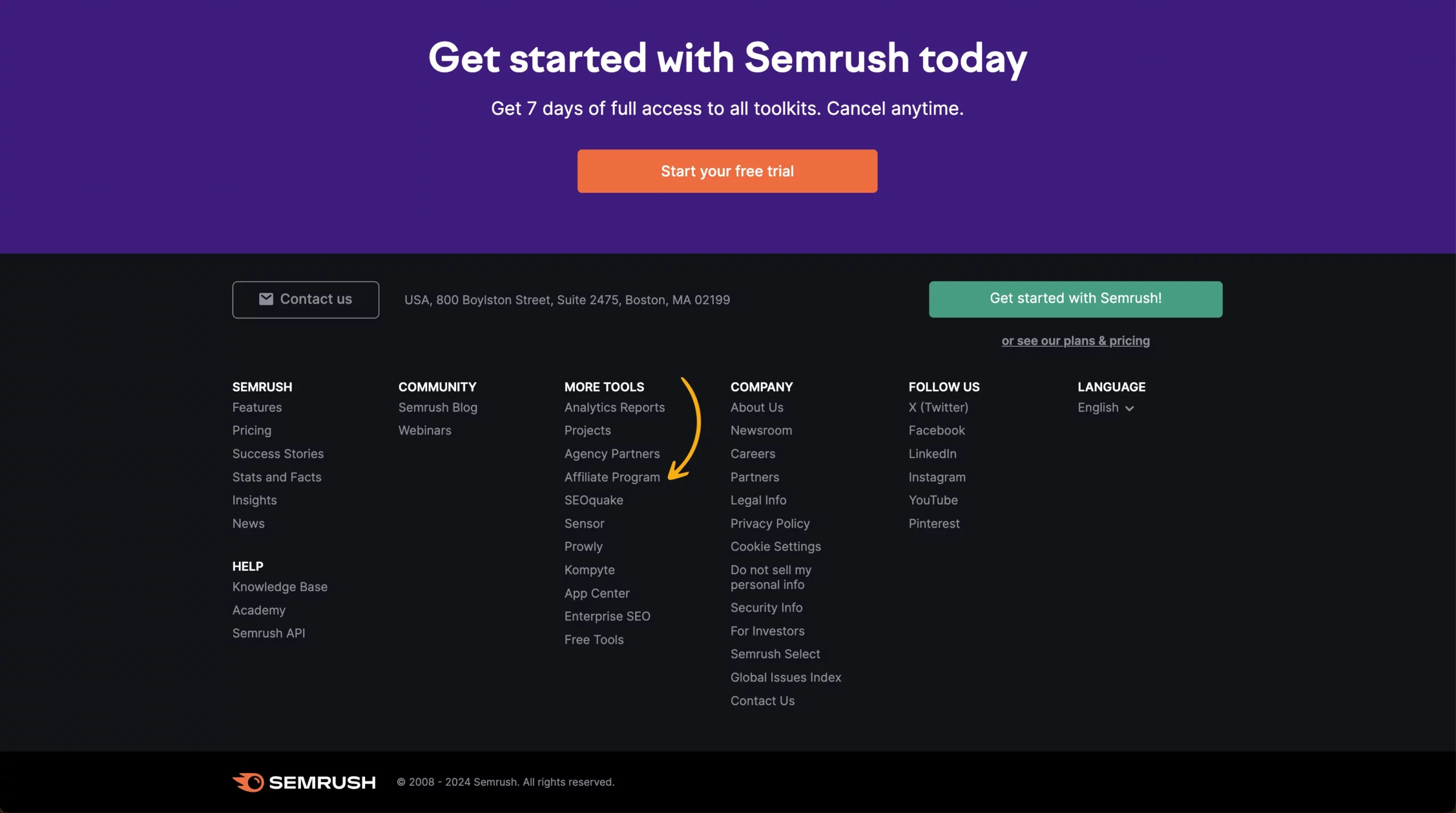
What should you do? Create a dedicated affiliate program landing page that clearly explains how your program works and the benefits of joining. Make sure this page is easy to find – place a link in your website’s footer or main menu and optimize it for search engines.
Use all the best practices for high-converting landing pages. For example, emphasize the desired outcomes and pain points. In addition, highlight success stories or testimonials from current affiliates to build credibility and trust – after all, social proof is the best tool in the golden times of social media.
4️⃣ Engage in Content Marketing

Content marketing can also help you attract affiliates. If you think that creating content to attract content creators is contradictory, then you’ve probably never been online 😉
In any case, content marketing is one of the main powers these days. And it works for all audiences — consumers, creators, businesses, etc. What exactly can you do?
Create high-quality blog posts, videos, and infographics that provide valuable information about your industry and products. Within this content, mention your affiliate program and the benefits of joining. This approach not only helps you recruit affiliates but also positions you as an authority in your field.
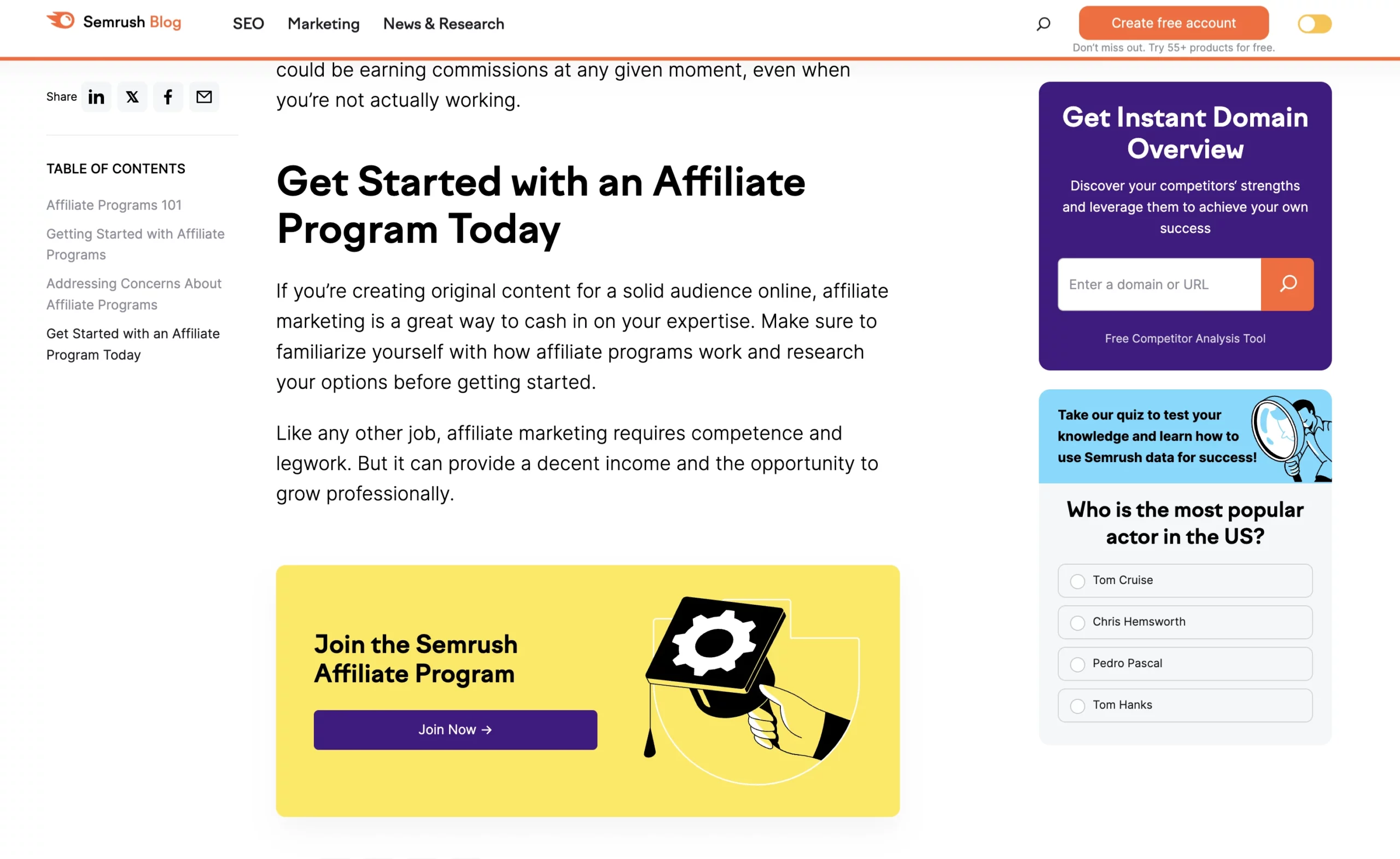
5️⃣ Collaborate With Complementary Brands

Instead of an affiliate network, you can partner with brands that complement yours but aren’t direct competitors. Co-host webinars, workshops, or online events where you both promote each other’s affiliate programs.
This way, you tap into a pool of potential affiliates who already have an interest in your industry but might not be aware of your specific program.
6️⃣ Look For Affiliates Who Promote Affiliate Programs

Not many companies use this, but if you think a little bit outside of the box, you will find this idea simply marvelous. By recruiting affiliates who are dedicated to promoting affiliate programs, you’re tapping into a network of people who understand the game and know how to play it well.
They can attract new affiliates to your program, which will expand your reach and boost your sales. Plus, their endorsements carry weight because they’re speaking from experience. It’s a smart, savvy move that can lead to exponential growth in your affiliate network.
So, how do you find these golden affiliates? Start by reaching out to influencers in the affiliate marketing space. Look for bloggers, vloggers, and social media personalities who talk about affiliate marketing strategies and success stories.
Alternatively, find those who simply make those blog lists like “Affiliate programs you can’t miss.” Engage with them, offer attractive incentives, and show them the potential benefits of your program.
With the right approach, you’ll soon have a team of affiliates who not only drive sales but also recruit more affiliates, creating a thriving, self-sustaining marketing ecosystem. It’s almost like having your own affiliate networks (small but effective).
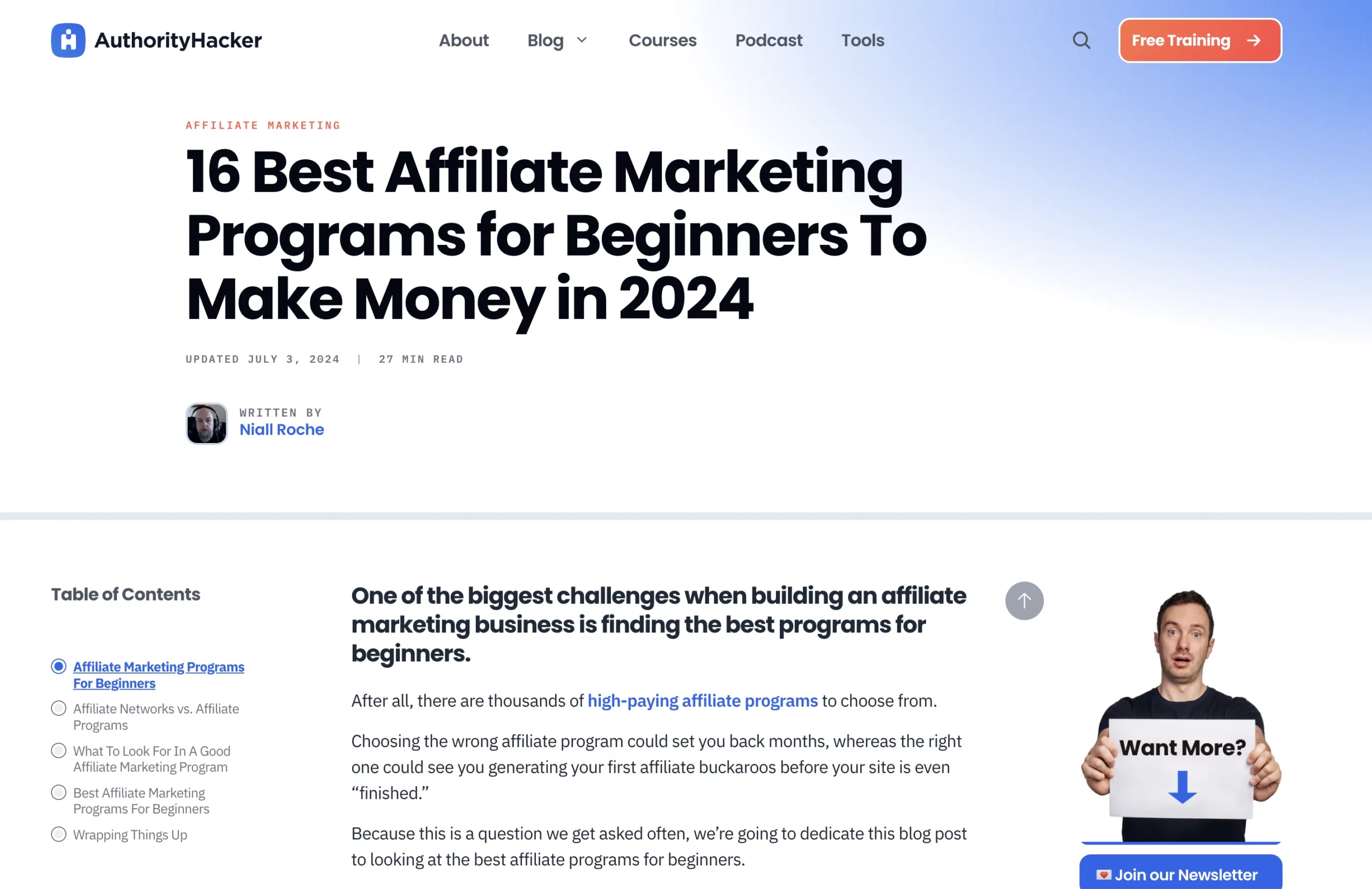
7️⃣ Run Google Ads

Simple? Yes, maybe. But it can be amazingly efficient. Running Google Ads to promote your affiliate program is a straightforward way to get in front of potential affiliates. With the right keywords and targeting, your ads can reach people who are actively searching for affiliate opportunities.
It’s like having a giant neon sign pointing straight to your affiliate program! Seriously – it can be literally among the first ones in Google search. So, if an affiliate marketer googles the best programs, yours will be right there.
And let’s be honest, who wouldn’t want that? Google Ads allows you to test different ad copies, adjust your budget, and analyze performance metrics to optimize your campaigns.
You can even target specific niches or geographical locations, ensuring that your ads are seen by the right people at the right time. Plus, with the power of retargeting, you can keep reminding potential affiliates about your program until they finally decide to join.
Downsides? Possibly, the biggest drawback of this tactic is its price. It isn’t the cheapest solution on the list. So, don’t rely on this method too much; try to grow other organic channels instead.
Conclusion
Now, you see that the best affiliate program depends on many factors, none of which are beyond your reach! Roughly 50% of your success can be guaranteed by the right choice of affiliate software. Not just because you would be able to accurately track all your affiliate partners and help them work better but also because you’ll give them a sense of transparency and trust.
The other 50%? That’s all about your creativity, strategy, and the unique touch you bring to your program. Tailor your incentives to your audience, maintain clear communication, and foster genuine relationships with your affiliates. This blend of solid tech and personal touch will set your program apart and drive impressive results.




